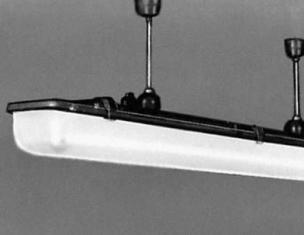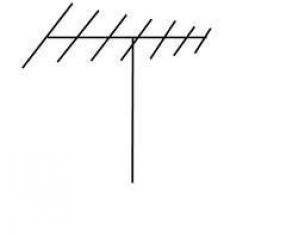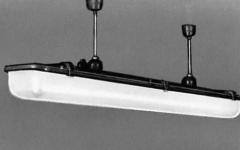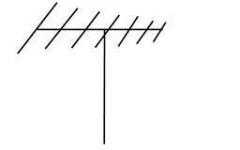When arranging a kitchen space, due attention is paid to the walls and floor. Here they are used as cladding different materials, but tiles are the most popular. Thanks to a wide range and high quality, it not only performs a decorative function, but also reliably protects wall and floor surfaces from adverse environmental factors.
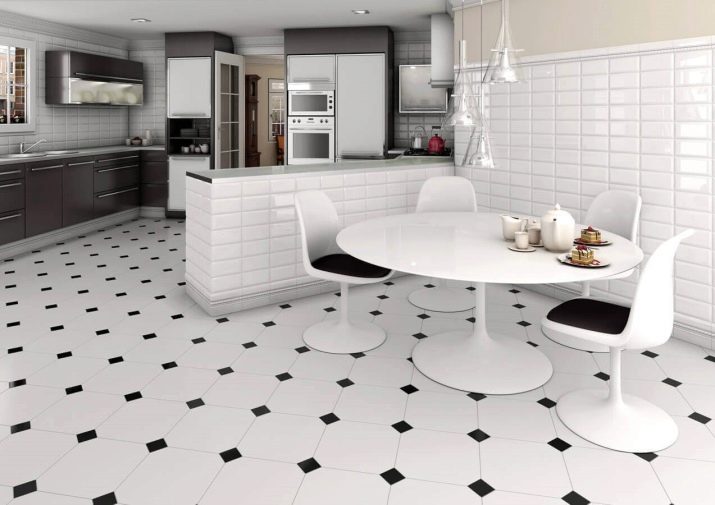
Advantages and disadvantages
When renovations begin, many are faced with the choice of how best to decorate kitchen surfaces so that they blend harmoniously with furniture and other interior items. It is generally accepted that the best finish for a kitchen is tiles. Its individual characteristics are the main priority in the selection process, so special attention is paid to these features. Kitchen tiles must be durable, reliable, practical and fully comply with GOST standards.
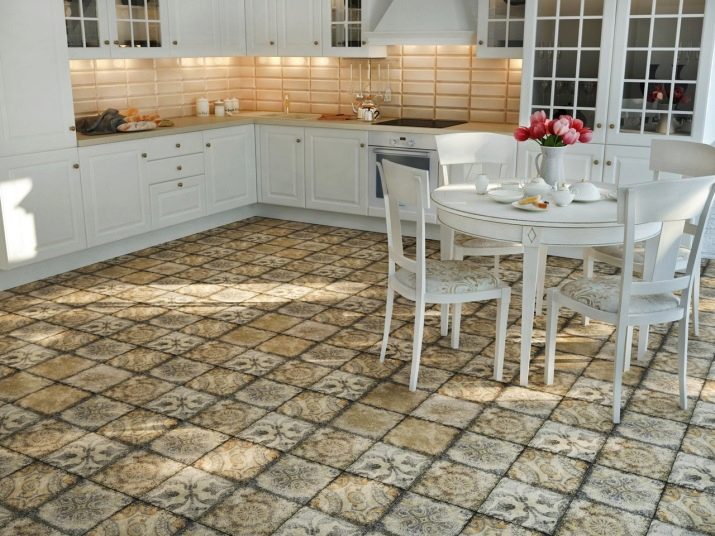
Modern manufacturers offer different copies of these products, both wall-mounted and floor options. The installation process is carried out on the entire wall or only where the work area is located. The important advantages of kitchen tiles include:
- durability;
- practicality;
- wear resistance;
- strength;
- fire resistance;
- resistance to chemicals and ultraviolet radiation;
- a wide range of;
- affordable price.
The disadvantages of this material are:
- cold surface;
- complexity of installation;
- poor sound insulation;
- high surface requirements.

Laying begins with careful preparation of the walls, which must be as smooth as possible so that the tiles have a presentable appearance. These tiles go well with drywall and, with the right approach, look like a single composition. Immediately after installation, grouting of the joints follows, which requires care.
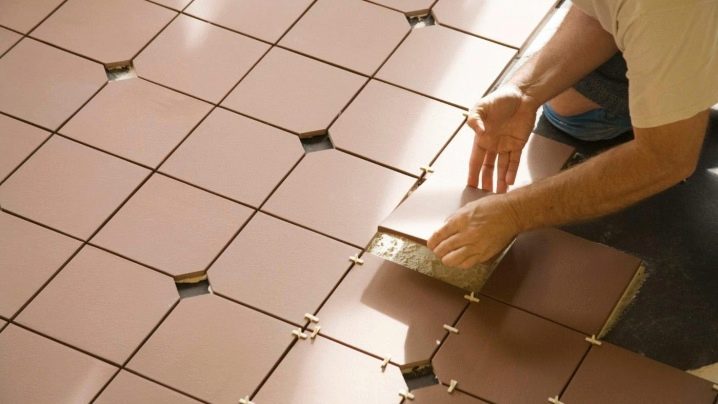
If the tiles are to be laid under the set, then it is necessary to take into account every detail so that they fully complement each other. After all, professional installation can add a touch of sophistication and originality to the kitchen space, as well as make it a favorite place to spend time.
Types of tiles
Tiles are made from a mixture of sand, clay and additional mineral components, which are subject to fire treatment, after which they are covered with a layer of glaze. It is small and more voluminous, which makes it easy to choose the appropriate option. Ceramic tiles are the most durable, so the demand for them increases every year. This facing surface looks original and very attractive. The tiles come in matte, glossy and sprayed finishes.
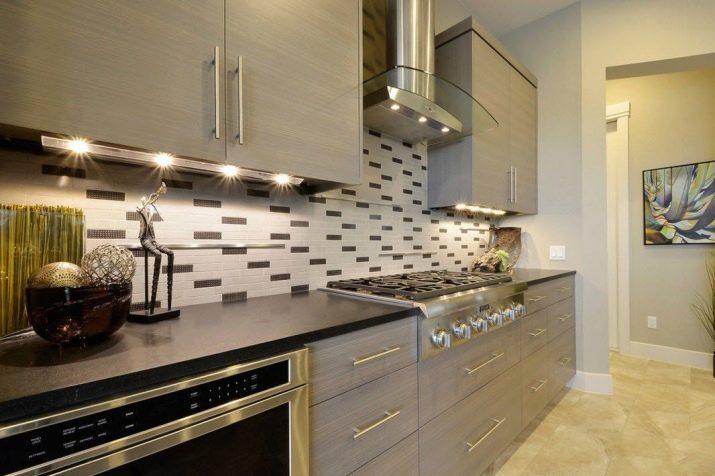
This material combines perfectly with glass and plastic surfaces. There are models imitating stone, imitating wood, mirrored, convex and with ornaments. No less in demand are gypsum tiles for the kitchen, which are characterized by a relatively low price and at the same time have excellent functionality. It can be small in size or voluminous.
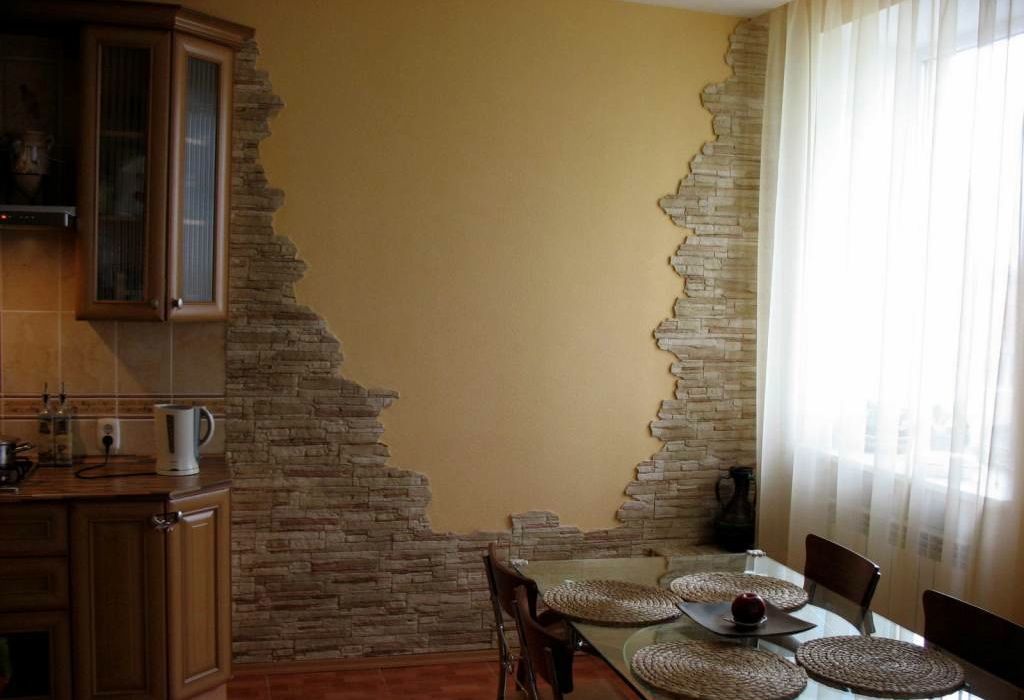
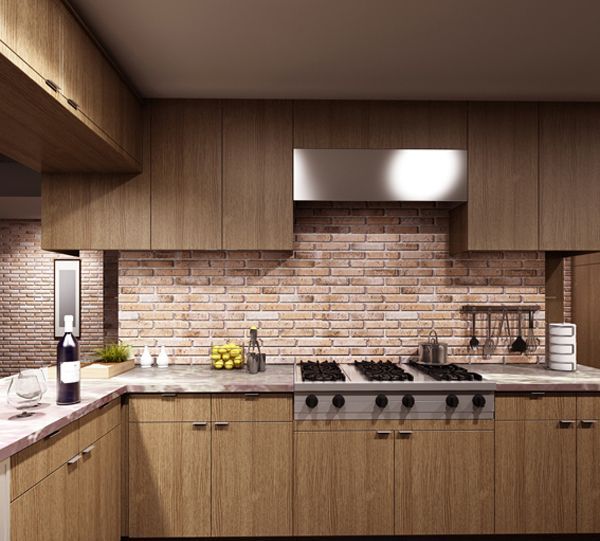
The range includes the following tile options:
- porcelain stoneware;
- clinker;
- plaster;
- stone;
- mosaic;
- majolica.
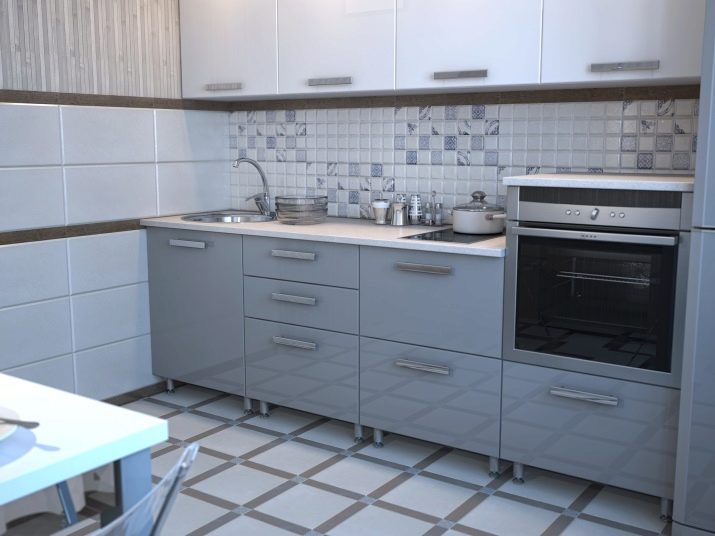
The highest strength indicators are found in porcelain stoneware tiles, which are resistant to moisture and are ideal for the kitchen. Clinker tiles are very similar to the first type and are often laid on the floor due to their non-slip surface. Gypsum mainly serves a decorative function, just like majolica and mosaic. Stone tiles look very stylish and complement other kitchen interior items well.
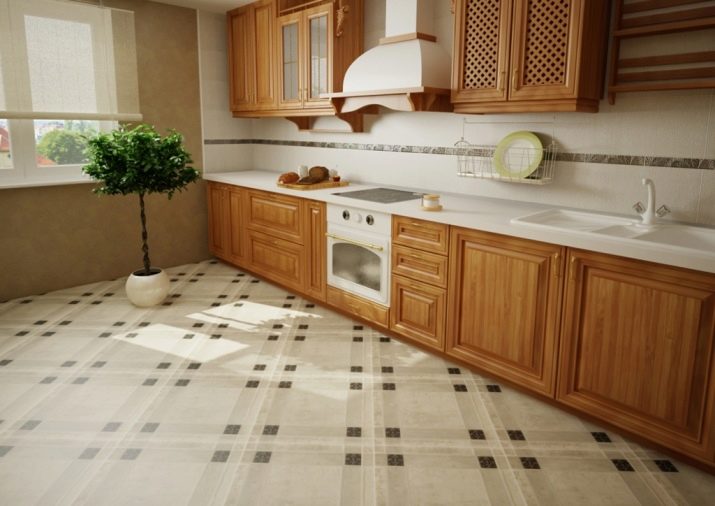
The Damasco and Tuscany mix collections are very popular. They are produced in different color solutions and textures, and are also distinguished by impeccable quality and durability. Such high-tech tiles perfectly retain their original appearance throughout for long years, decorating the kitchen and filling it with a positive atmosphere. Models are available for walls and floors, allowing you to create unique compositions in kitchen areas.
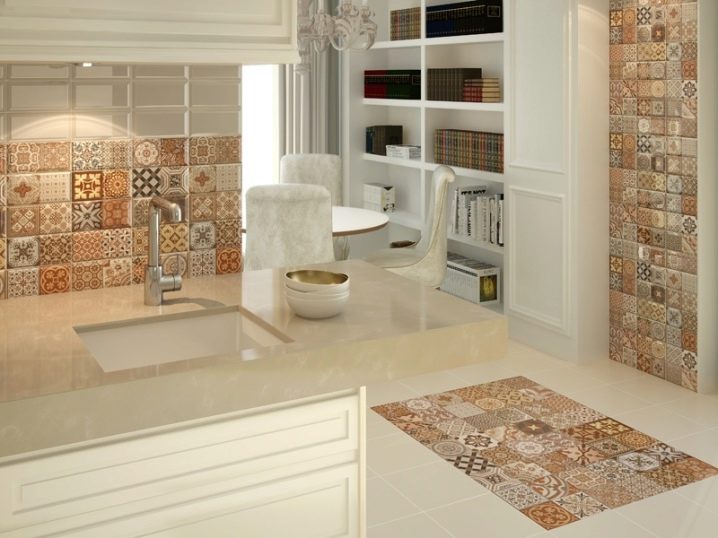
Choice: what to look for
A finishing material such as tile must be chosen so correctly that it fully corresponds to the functions assigned to it. That is why different requirements are imposed on wall and floor products, which should definitely be taken into account in the selection process. But regardless of the purpose of the tile, experts recommend carefully studying the technical features, information on the packaging, as well as the presence of a quality certificate. All these factors are equally important when purchasing tiles.
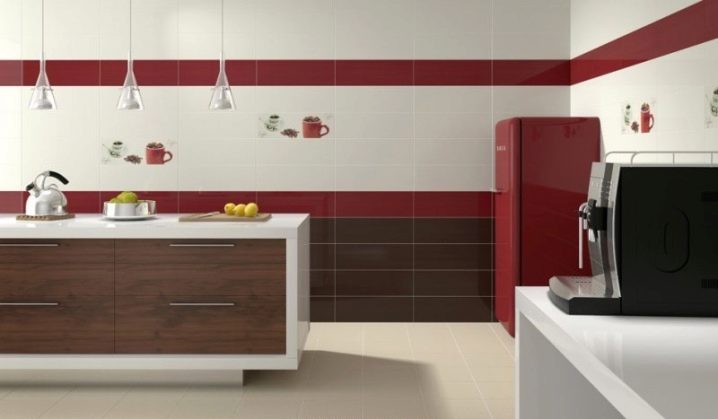
Based on the type of production, a distinction is made between pressed and extruded ceramics. It can have a glazed or unglazed coating. To make the most right choice The following rules must be observed:
- carefully check the strength and integrity of the material;
- make calculations with a margin of about 15%;
- for walls, select models with an ideal surface, and for the floor it is better to buy rougher ones;
- the level of moisture resistance must be at least 0.03%;
- the cost directly depends on the size of the products; the smaller the size of the tiles, the more expensive the price.

When choosing tiles, safety criteria are also quite important, such as:
- wear resistance class;
- degree of hardness;
- friction coefficient.
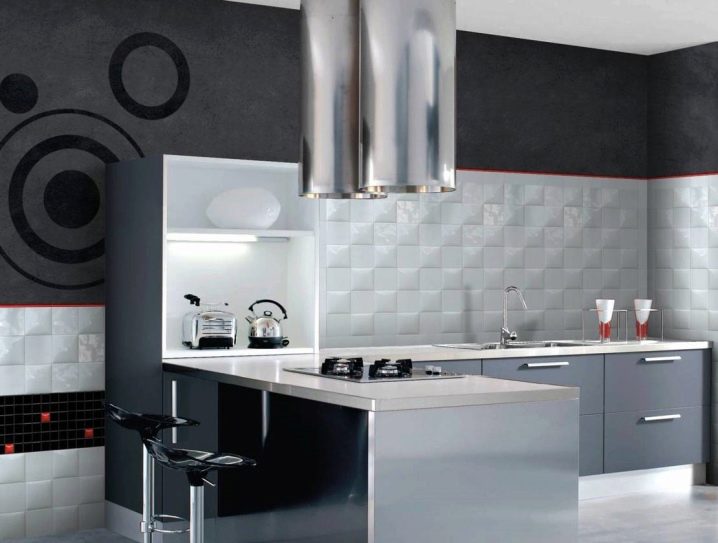
There are 5 wear resistance classes, of which optimal solution for the kitchen are products of classes 3 and 4. Regarding hardness, tiles with a seventh degree are best suited here. For flooring, specimens with a friction coefficient of at least 0.75% are perfect. Taking into account all these features, you can lay out an original carpet from tiles that match the overall design. The most common sizes are compact models 20x20, and the larger ones are 20x50 and 20x60.
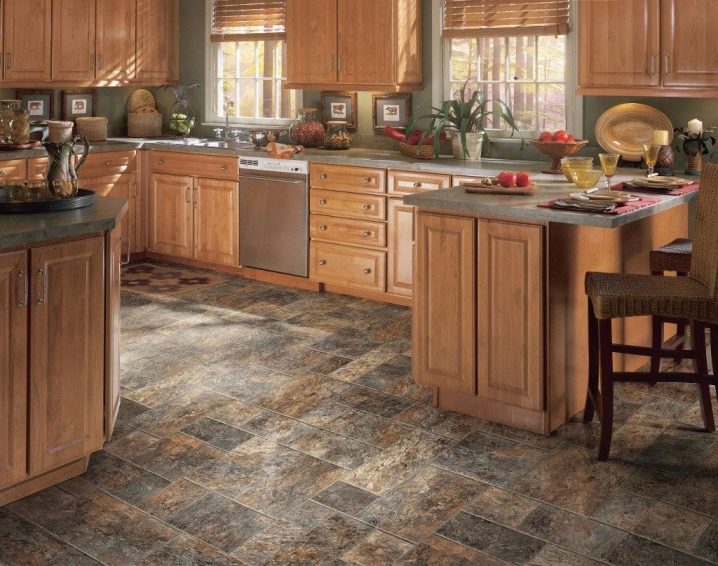
A huge variety of tiles makes it possible to embody the most extraordinary ideas and create a unique interior in the kitchen. Basically, the choice of this finishing material is based on the general stylistic design and consists of various kinds of nuances.
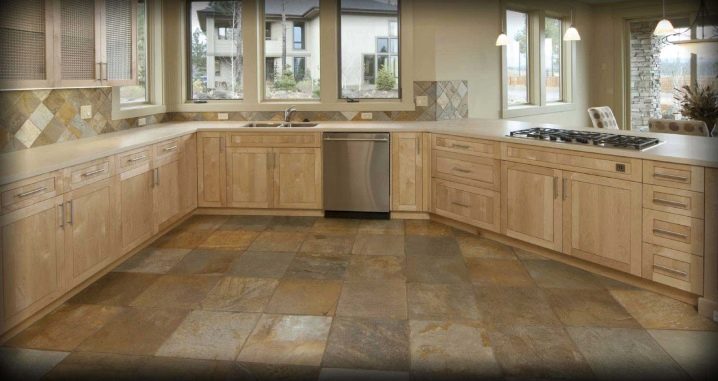
Professional designers advise:
- use large tiles in light colors to visually expand the space;
- do not use more than three different colors at the same time, so as not to disturb the harmony of the kitchen interior;
- take into account the degree of future contamination of products, based on which, make a choice by color.
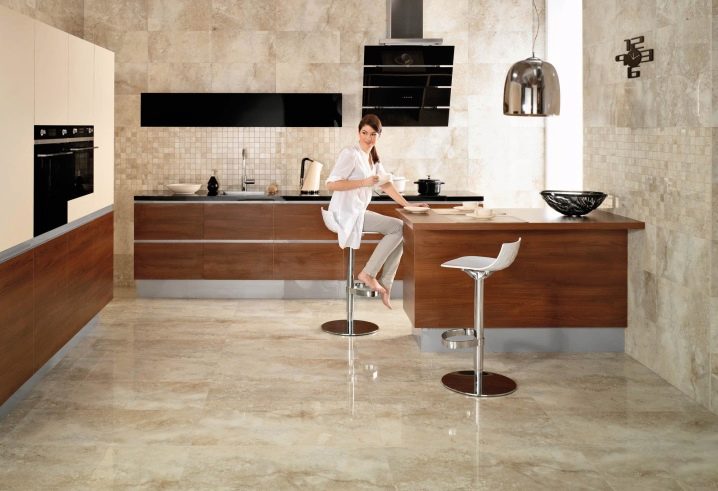
The most practical and suitable for the kitchen are considered to be gray, beige and brown shades. They are resistant to stains and, at the same time, significantly expand the area, which is an advantageous factor for small kitchens. The size of the tiles is also important in many respects, because large squares fill the kitchen with space, and rectangular products lengthen it. Looks good floor tiles, lined with diamonds or other simple patterns. It can be plain or decorated with decorative patterns.
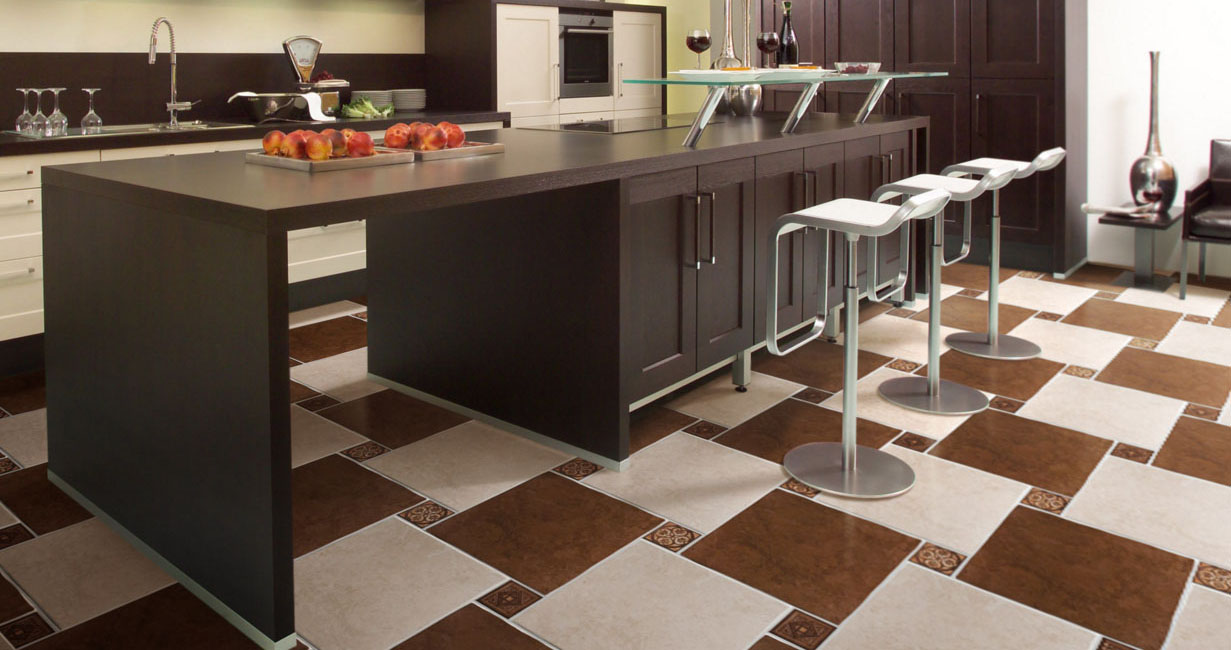
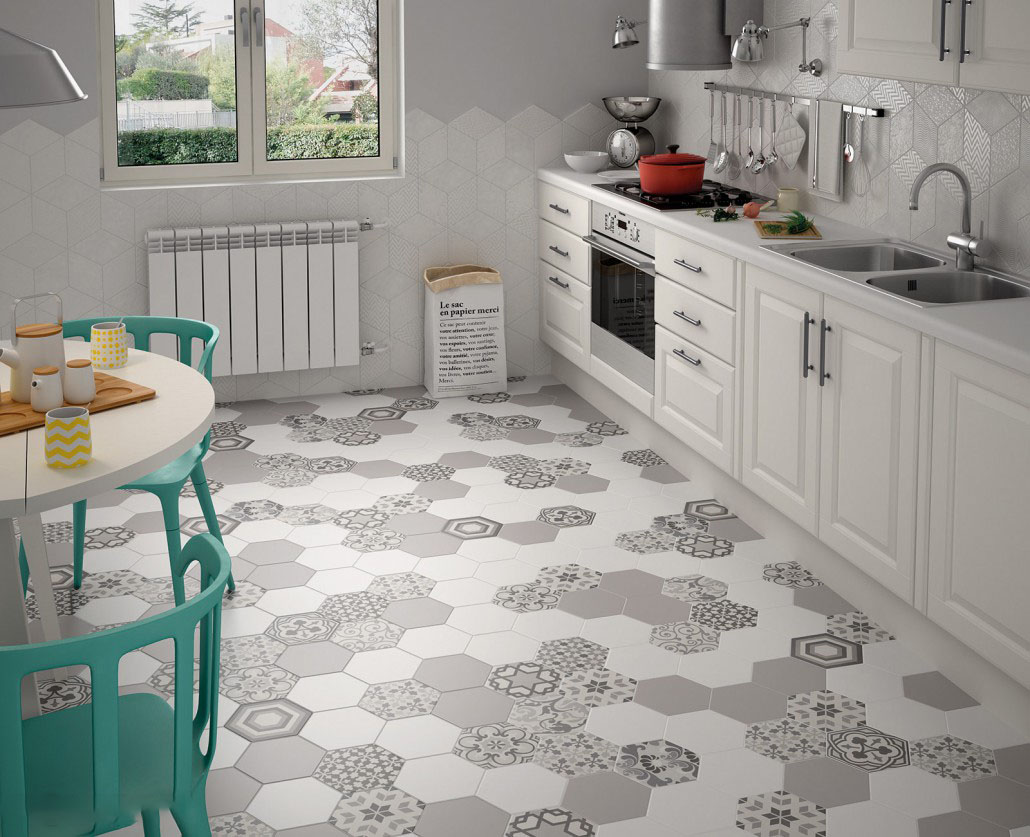
Apron design: characteristics and design
The work area in the kitchen is often decorated with a so-called tiled apron. It reliably protects the walls from adverse factors and is a beautiful decoration of the kitchen space. This part can be bright, unusual, designer or any other format.
It’s good if the texture of the tiles on the backsplash is characterized by minimal porosity, this will make it easy to clean it from various types of contaminants. Facing over work surface must be thermally resistant and able to withstand heat up to 120 degrees.
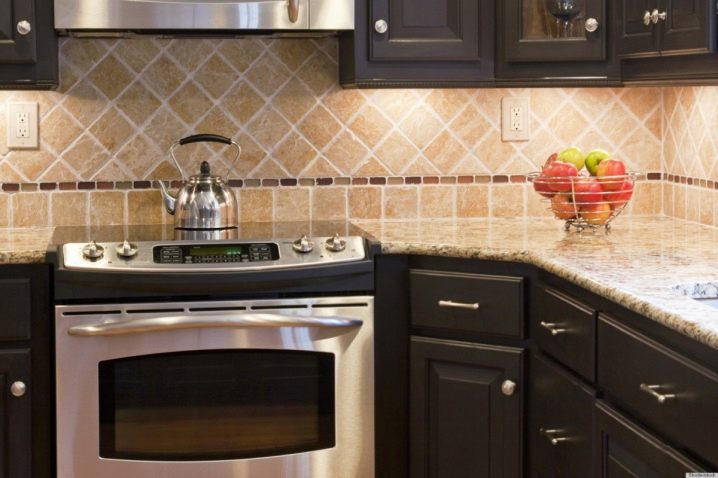
In kitchens with a restrained design, it is recommended to use plain tiles or glass instead of tiles. If difficulties arise during the design process, the use of white tiles is allowed, since this color is universal and fits harmoniously into almost any environment. The tiles on the apron look original, matching the contrast to kitchen set. At the same time, there is no need to overload this area with decorative inserts so that it has a presentable and stylish appearance.
Fashionable solutions in the interior
IN Lately Designers began to use a variety of original styles when decorating kitchens. The ideal option is the one that matches the style general arrangement Houses.
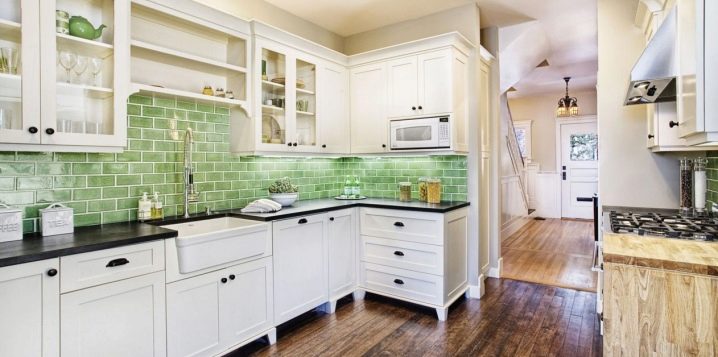
The following interior design solutions are provided:
Classic style. Fits perfectly under white kitchen, since it allows the use of white, black and gray tones. Light or dark tiles with a discreet pattern or texture like natural stone are appropriate here.
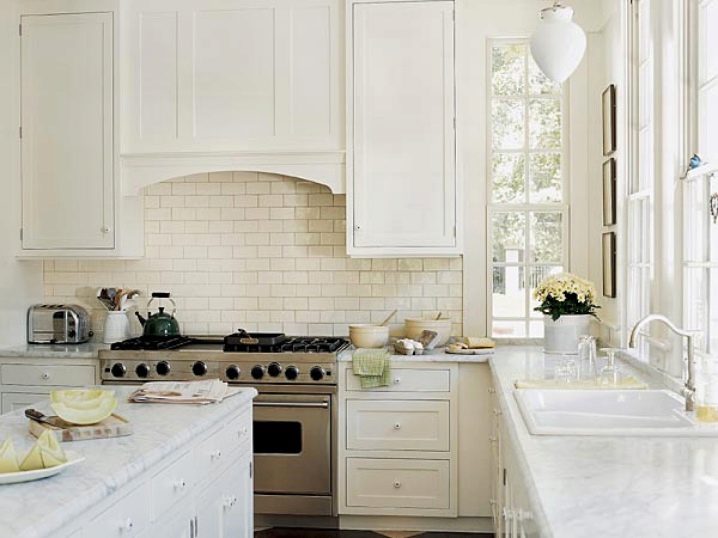
- High-tech style. It is a fairly modern design direction dominated by dark colors, so it's perfect for dark kitchen, surprising others with elite patterned tiles.
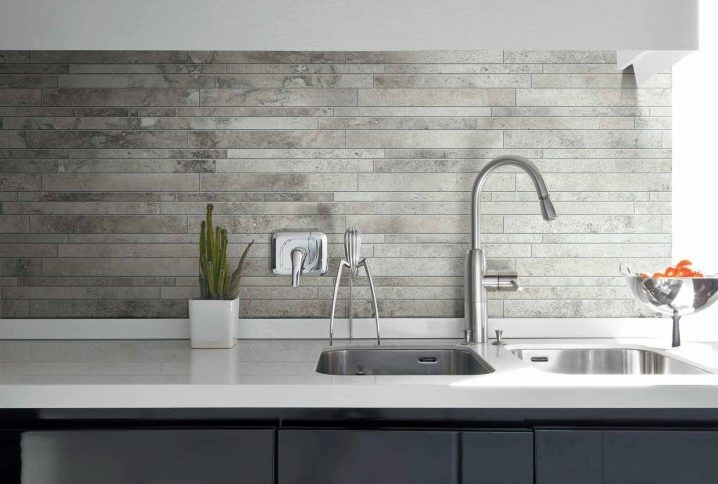
- Provence style. The kitchen in the Provence style is decorated in pastel shades, color scheme which can be beige, pink, white, mint and blue tiles.
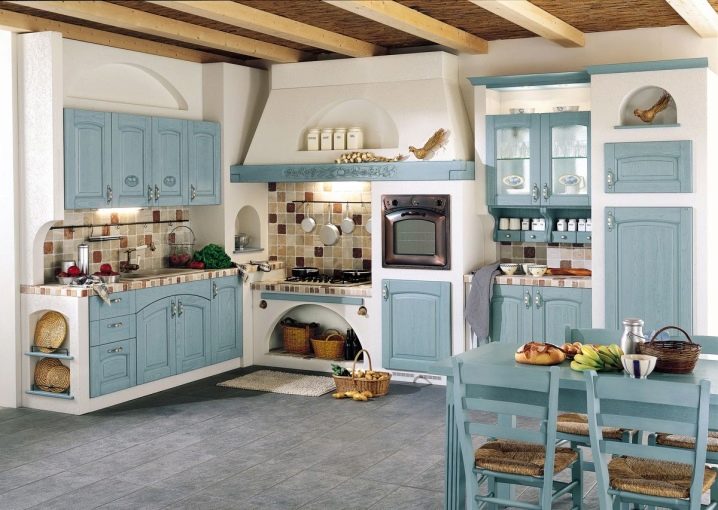
- Art Deco style. It attracts attention with expensive tile samples, the range of which includes matte, glossy, voluminous, rectangular, square, diamond-shaped, wide, narrow, with flowers, with fruit, as well as designer 3D tiles.
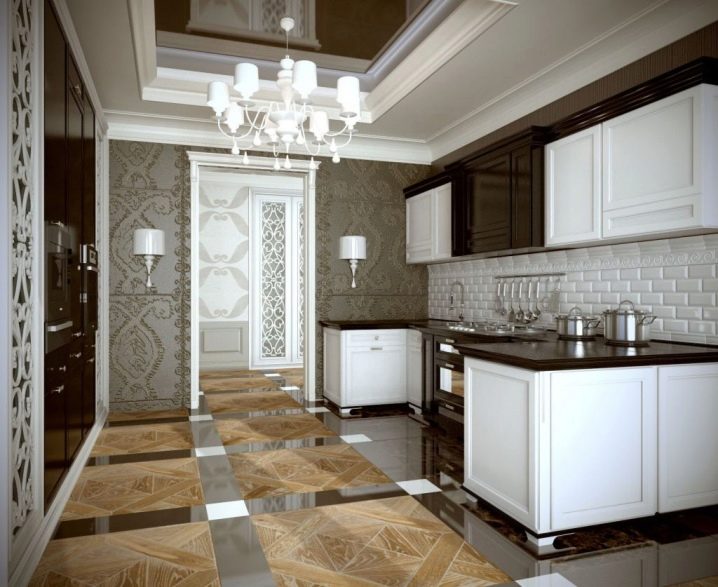
- Country style. Outwardly resembles country cuisine, although it uses a lot modern materials. Collections of ceramics in this direction represent an imitation of natural Decoration Materials. It can be printed with a designer print or images of coffee, daisies and other elements suitable for the theme.
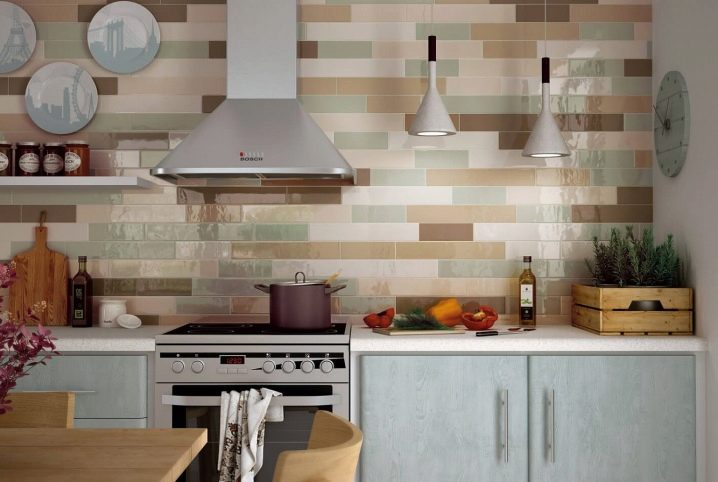
- Scandinavian style. It is typical for him a large number of light, so wall and floor tiles here are suitable in light colors. Wood-effect tiles look very practical and beautiful in the Scandinavian style, creating a feeling of comfort and coziness.
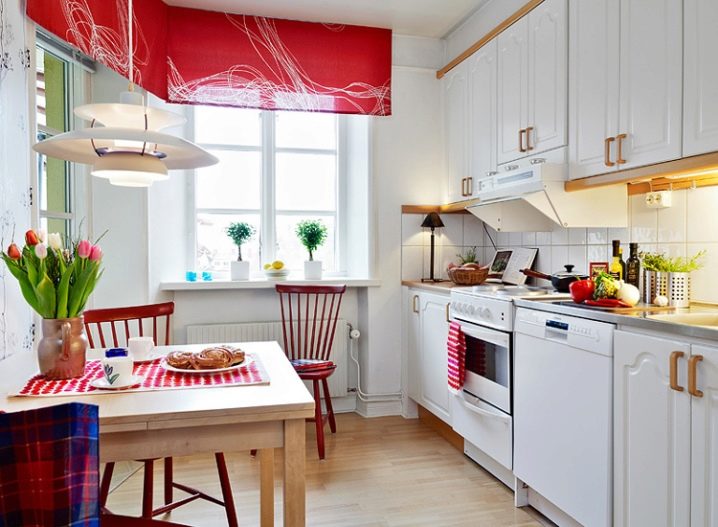
- English style. An English-style kitchen is distinguished by sophistication, excellent lighting and high-quality finishing in the form of elegant tiles in natural colors, among which beige, light green, brown and white are in great demand. In some cases, mother-of-pearl ceramics can be used in a color that matches the interior.
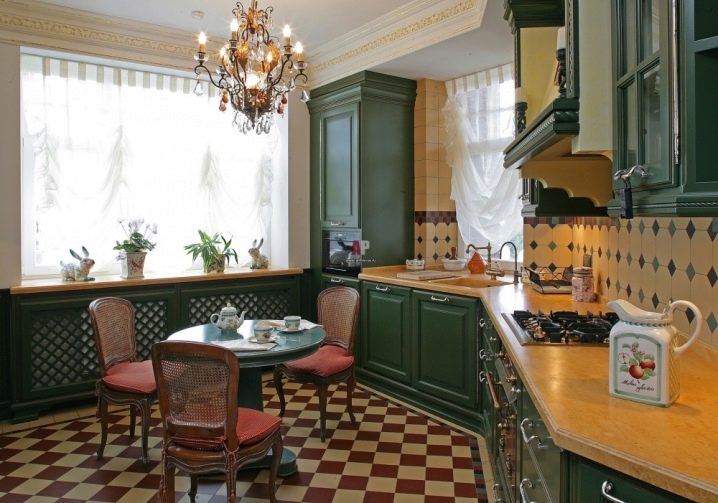
Modern tendencies allow you to use a special screen instead of tiles. This feature is characterized by functionality and practicality, so the quality is not much inferior to ceramic coatings.
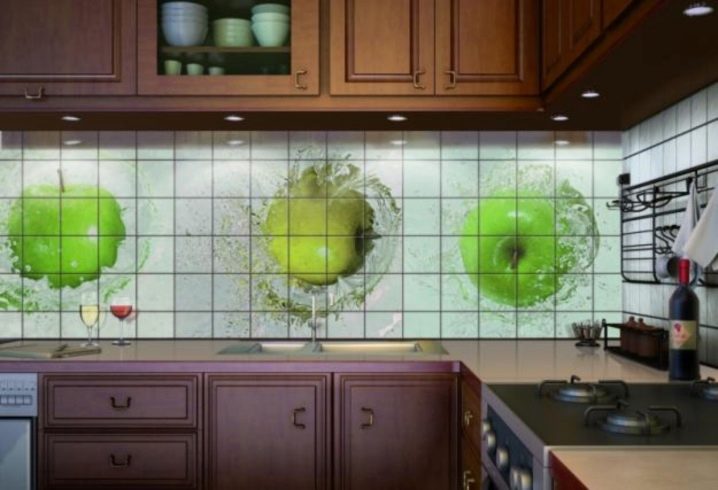
If you pay attention to the rating of manufacturers, then high positions in the world market are occupied by such brands as Metro and Surrey. Their products fully meet the norms and quality standards, which makes them in demand in different parts of the world.
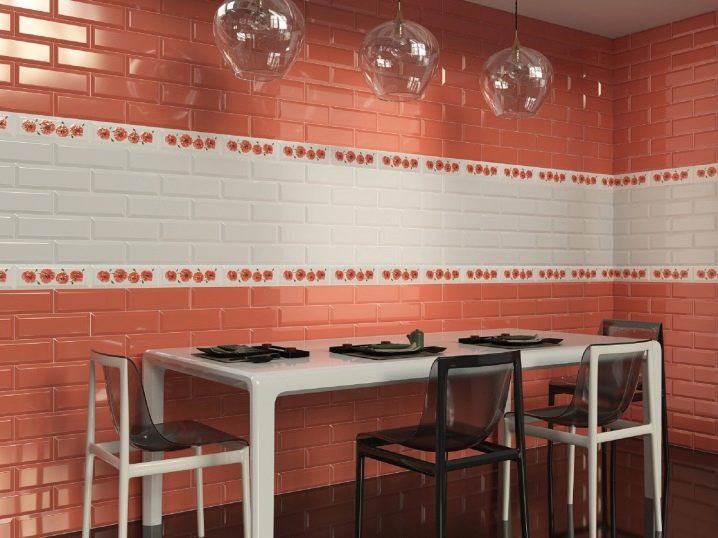
The tiles are laid entirely or broken into segments, from which original compositions are subsequently laid out. Patterns can be very different, from familiar images of fruits to complex landscapes. Where appropriate, ceramics are used to decorate baseboards and borders, which looks very stylish. With the right lighting, such unique design solutions look especially beautiful.
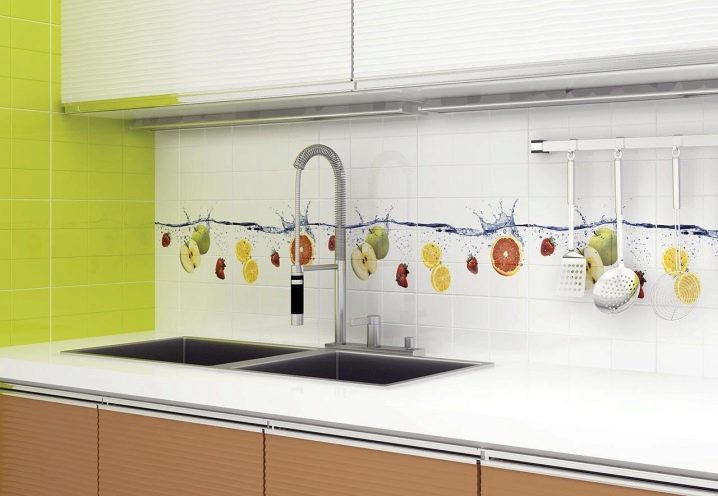
Rules of care
To ensure that the tiles in the kitchen do not lose their original qualities over many years, they need to be proper care. To do this you need to know some rules:
- do not use metal brushes or other abrasive materials on glossy ceramics;
- do not overuse aggressive detergents so as not to damage the seams;
- to remove greasy deposits, use a solution of water and vinegar;
- To add shine, you should add a little ammonia to the washing water.
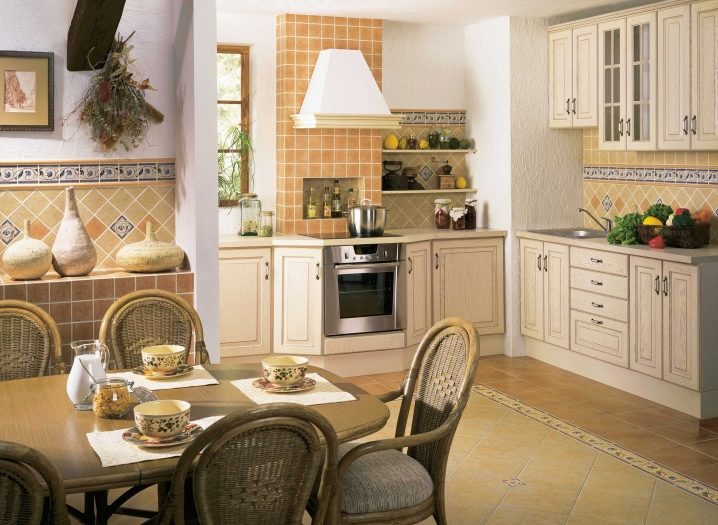
You can always update the cladding in the form of kitchen tiles with your own hands, giving it newness and presentability. In order to achieve the desired result, you can paint the tiles using paint suitable color. At the same time, the paint must be resistant to grease, dust and soot. Seams treated with epoxy materials do not collapse much longer. Painting tiled walls can freshen up a kitchen space and give old tiles new life.
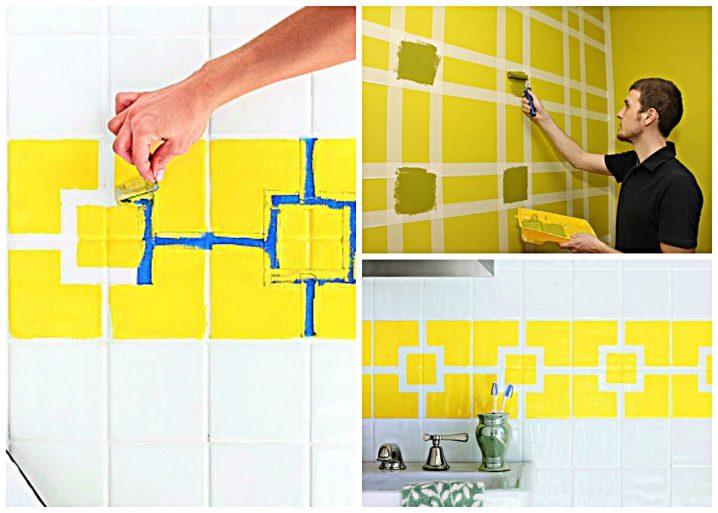
When starting to clean tile surfaces, it is recommended to use detergents specifically designed for them. They carefully care for the tiles, easily remove dirt from its surface, and also prevent the appearance of dullness and brightness on the cladding. They contain components that actively eliminate unpleasant odors and protect plumbing fixtures from the formation of mineral deposits and microorganisms.
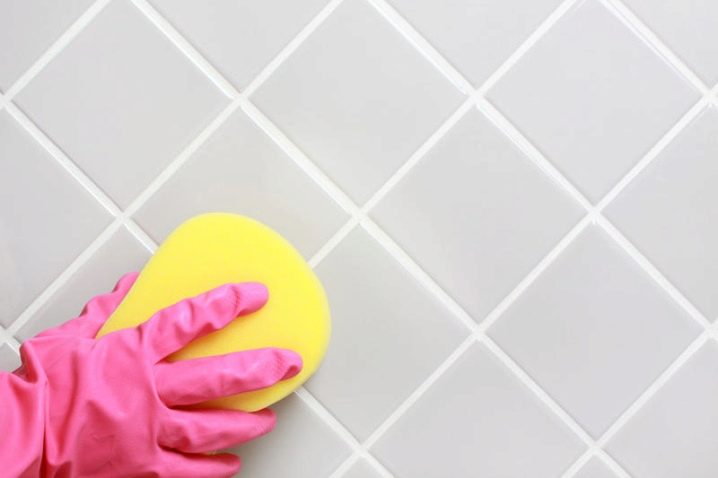
Thanks to high-tech devices, kitchen tiles from modern manufacturers surprise with their incomparable durability, chic design and wear resistance, which makes them the most popular finishing material in the kitchen.
Many housewives prefer to use wax to create shine. It not only cares for the tiles, but also creates a protective layer on its surface, thereby extending the life of the material. Regarding floor tile models, they should be looked after more carefully. To do this, you need to lay a shoe carpet at the entrance, which will protect it from unwanted scratches and chips.
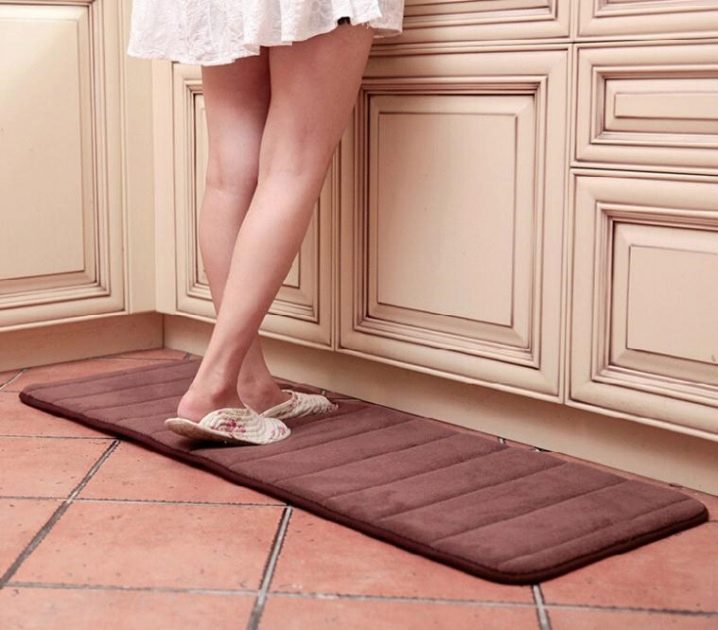
Numerous reviews indicate that tiles have the highest levels of practicality and durability compared to other finishing materials. Particular emphasis is placed on its decorative function, because each collection is a real work of art, which amazes with its versatility, huge selection and stylish design ideas. Such features are the main priorities when choosing finishes for the kitchen.
Finishing the kitchen backsplash with bright red hog tiles
Tiles in the kitchen is an excellent and practical decoration option, so it’s no wonder that a model such as the boar tile on has become popular. Using tile materials for the purpose work area lining, you can recreate absolutely any interior, the main thing is that it suits your liking and style.
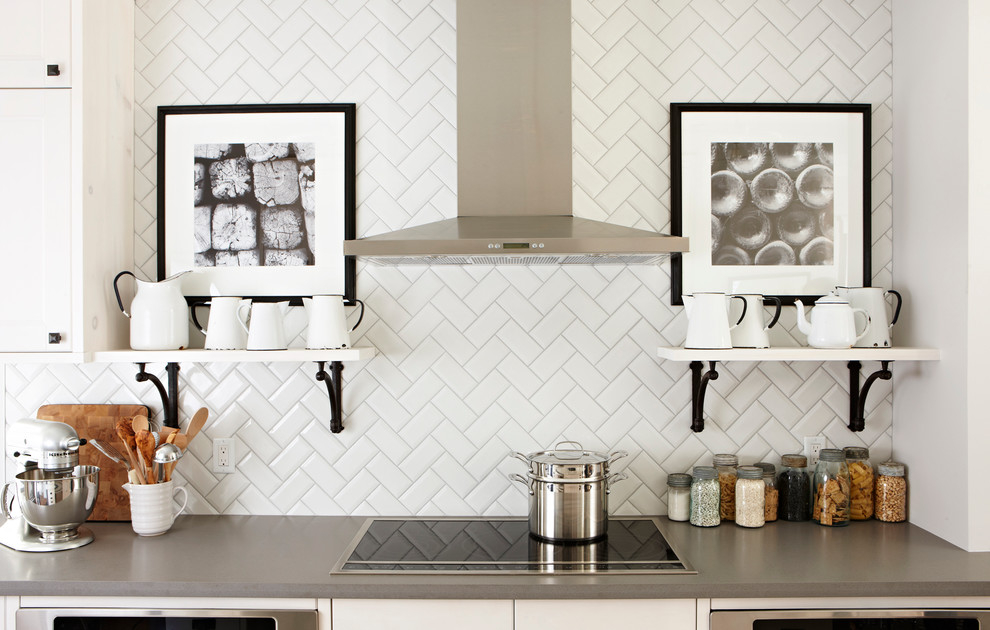
Tile "boar" in the shape of a herringbone
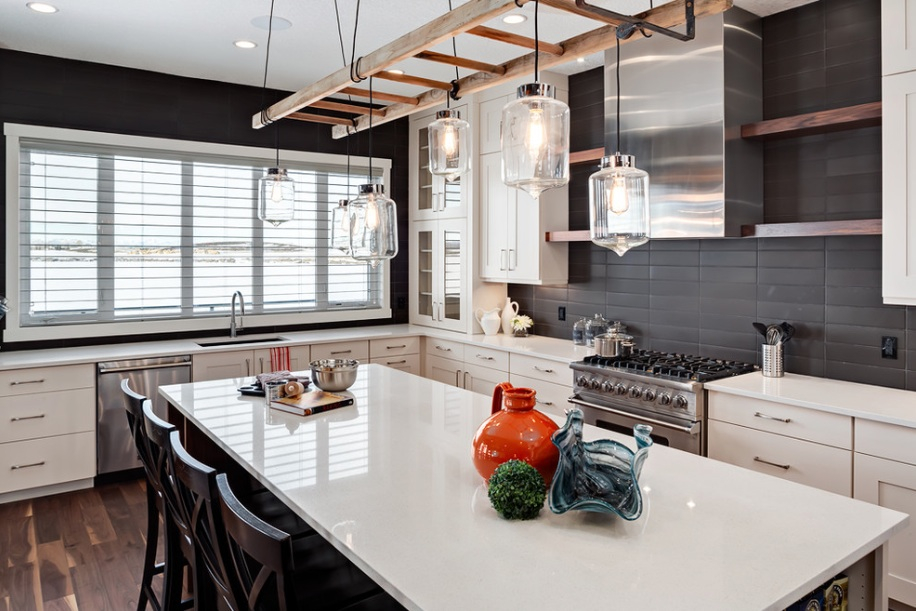
One of the types of tile laying “hog” on the apron in the kitchen
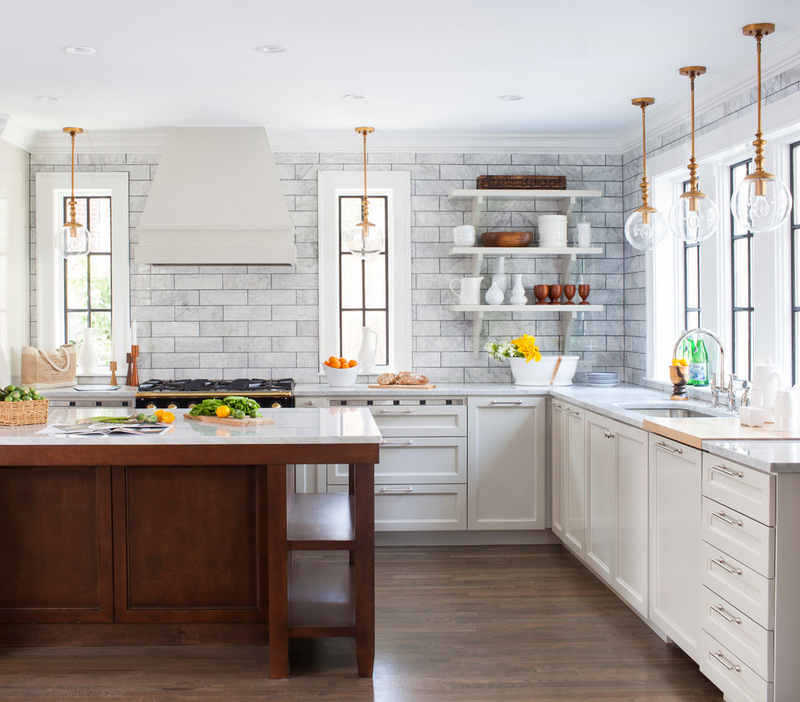
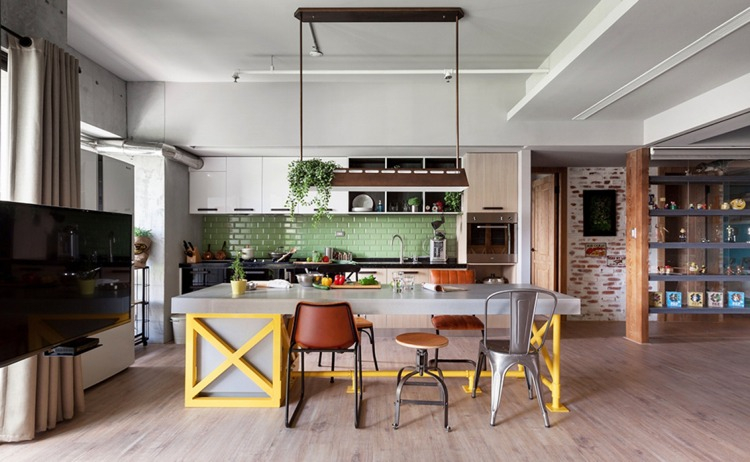

An excellent combination of bright furniture set with gray hog tiles
Requirements for finishing elements
it can be anything, and this factor is taken into account when choosing compositions. Sometimes even the most expensive product may not be to the buyer’s liking due to the low quality of the material, but each type of finishing work requires a certain quality and style of material. That is, if the tile is from Italy and meets all the norms and standards of the country, this does not mean that it will meet your specific conditions of use.
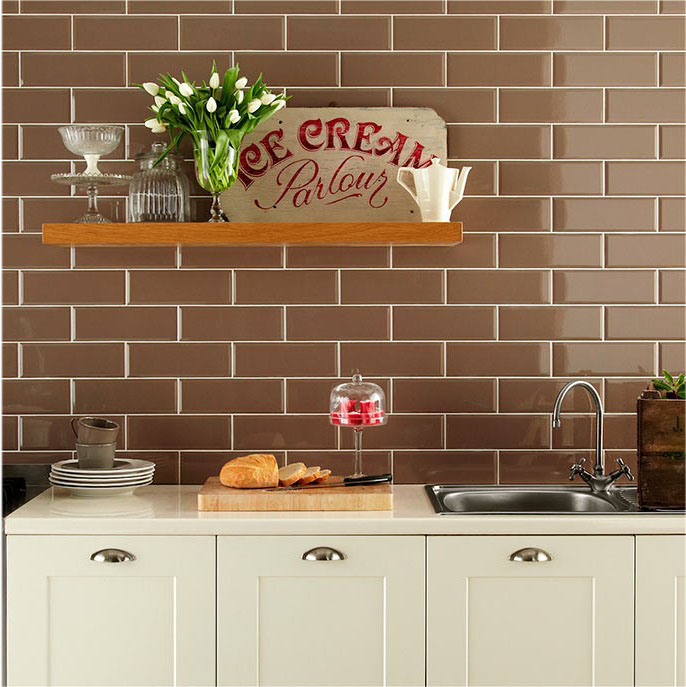
Decorating the walls in the kitchen with coffee tiles to look like brickwork
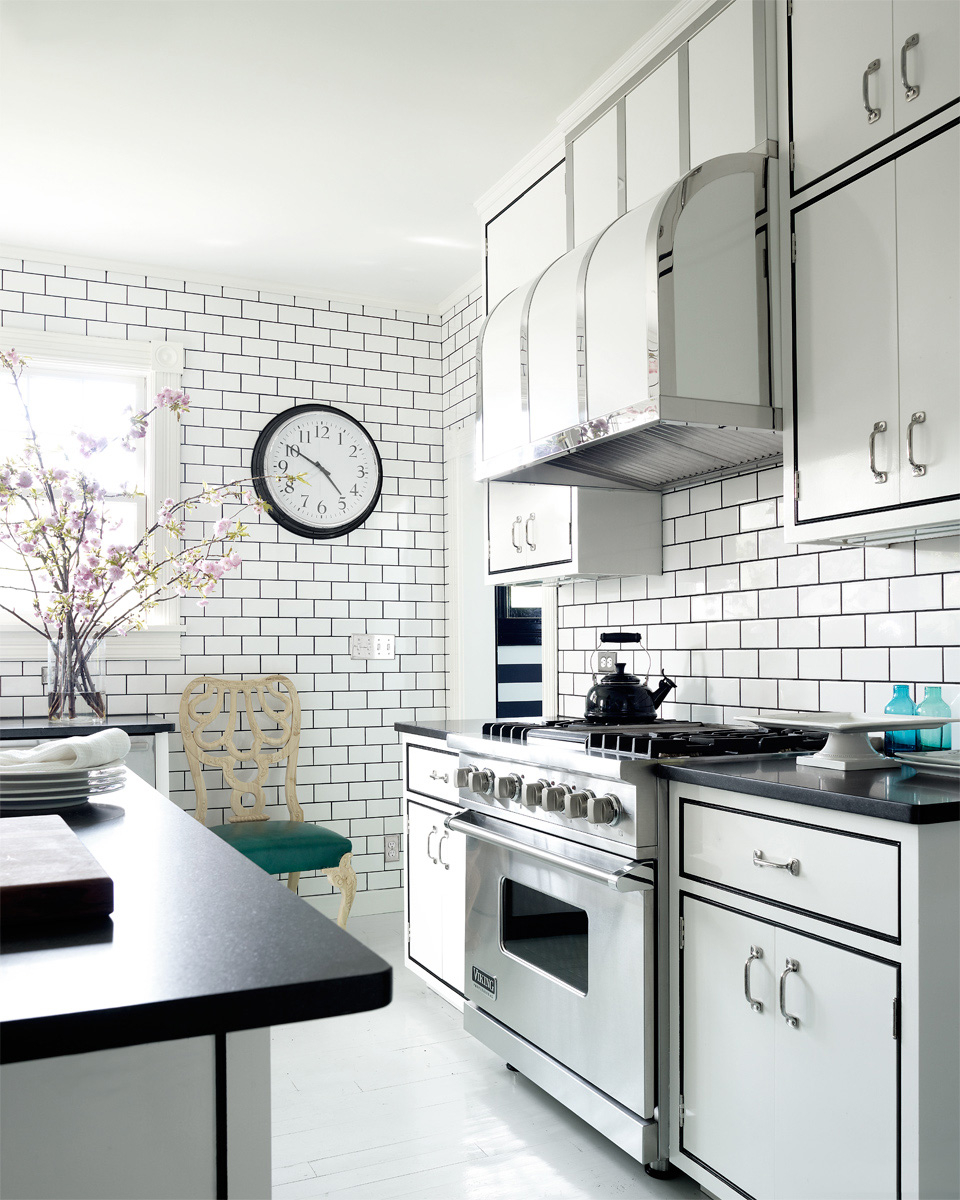
Classical white tiles"hog" with contrasting seams
Kitchen backsplash design
The “hog” tile is a tribute to modernity. The facing material received its name due to the presence of two holes at the end of the blank, which is used to make tiles, and in appearance the material is similar to the snout of a pig.
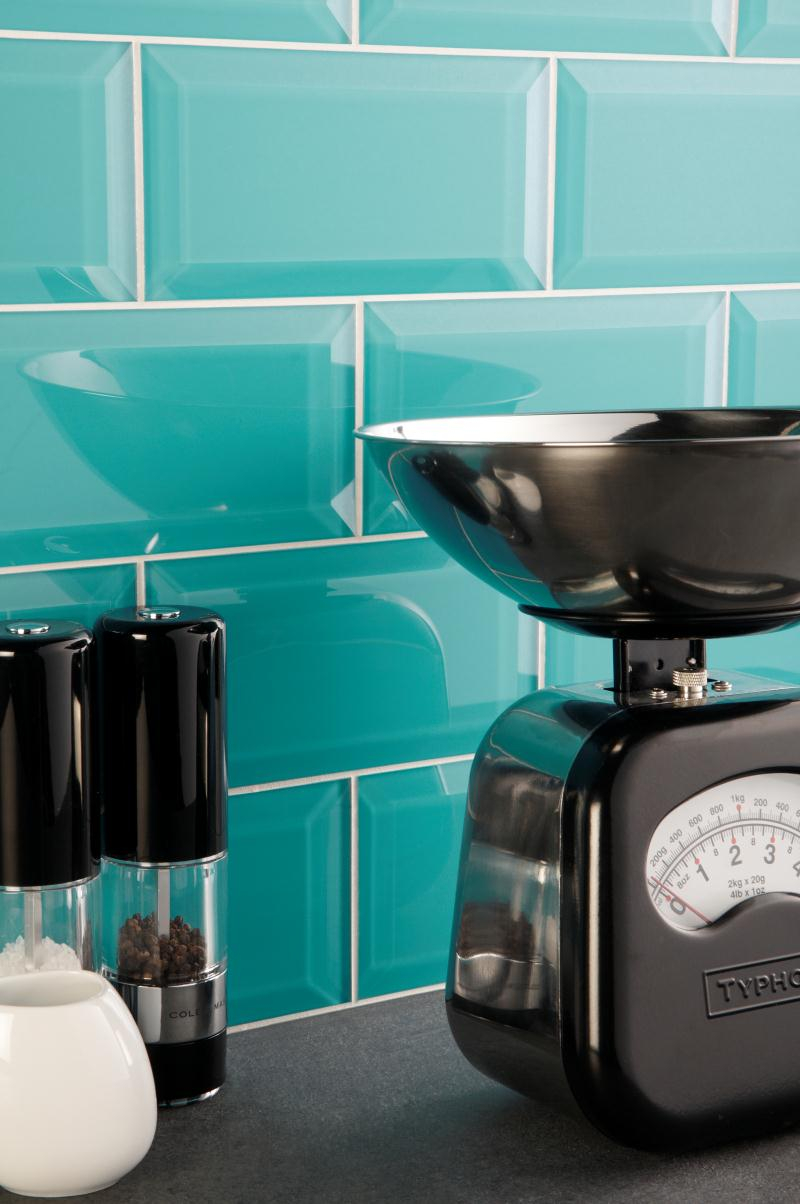
Such tiles became fashionable back in the last century and were traditionally used as a material for numerous public buildings and wall structures in metropolitan cities, which is why in Europe this model was called “metro.” Modern design solutions are impossible without the use of this tile. But before you proceed directly to purchasing products, you need to study the variations offered by the market.
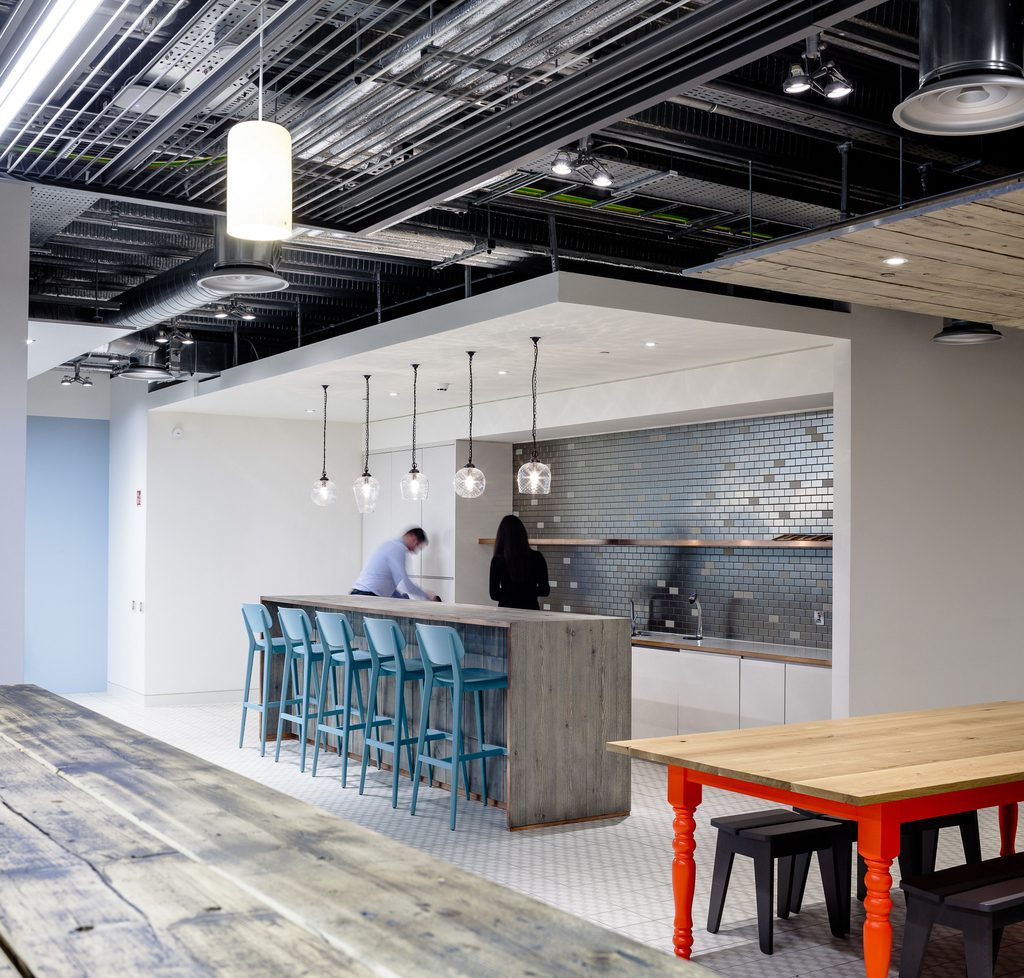
Working wall modern kitchen with hog tile trim in metallic color
Product Features
The “hog” tile in a modern look is a ceramic product in one tone, equipped with a smooth surface and elongation. In the interior, thanks to the use of such a product, you can easily recreate a three-dimensional format. Regarding the surface of the product, it can be textured or glossy, can be performed as a result of artificial aging techniques.
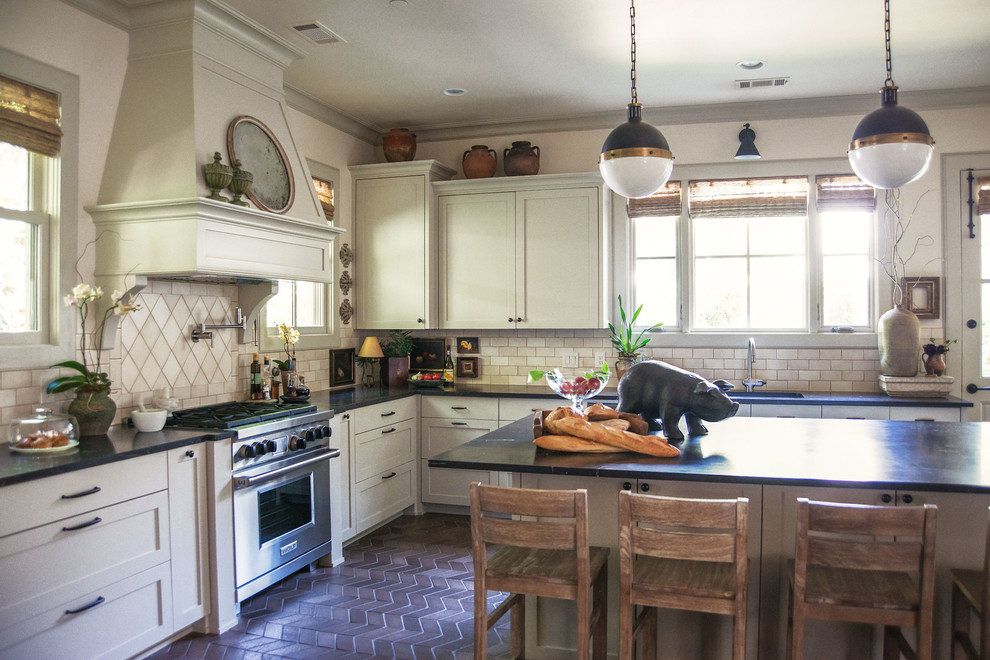
The color palette of solutions in this direction is huge, and each owner can choose both bright, saturated and calm ones. pastel shades. But most often it is the white “hog” tile that is used. You can buy material of this type in many places, but sometimes what seems boring to many people can be diluted with original decorations, borders and contrasts.
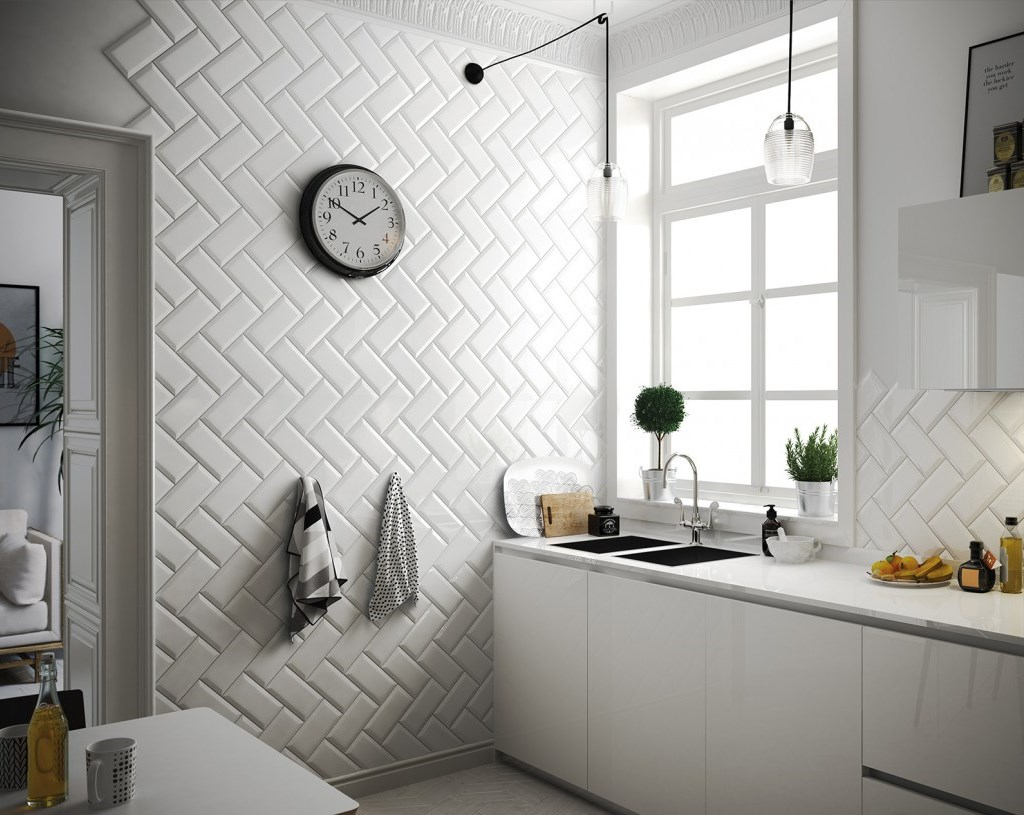
Finishing kitchen walls with white hog tiles in the shape of a herringbone
Dimensions
The length of the tile created is 2 times the width, and sometimes 3. Standard sizes depend on the specific manufacturer, and popular collections may vary. The length varies from 12 to 30 cm, and the width parameter is 6-10 cm, respectively. Basic characteristics – 7,5*15. 10*20, 15*30.
![]()
Non-standard elongated “hog” tile shape
Advantages
“Boar” was able to gain widespread popularity due to the advantages it offered.
- Variety of color designs;
- Resistance to the influence of a humid environment;
- Resistance of the product to temperature changes;
- Easy care and unpretentiousness of the material;
- Length of useful life;
- Use of environmentally friendly material;
- Possibility of application in every solution;
- Increased decorative characteristics.
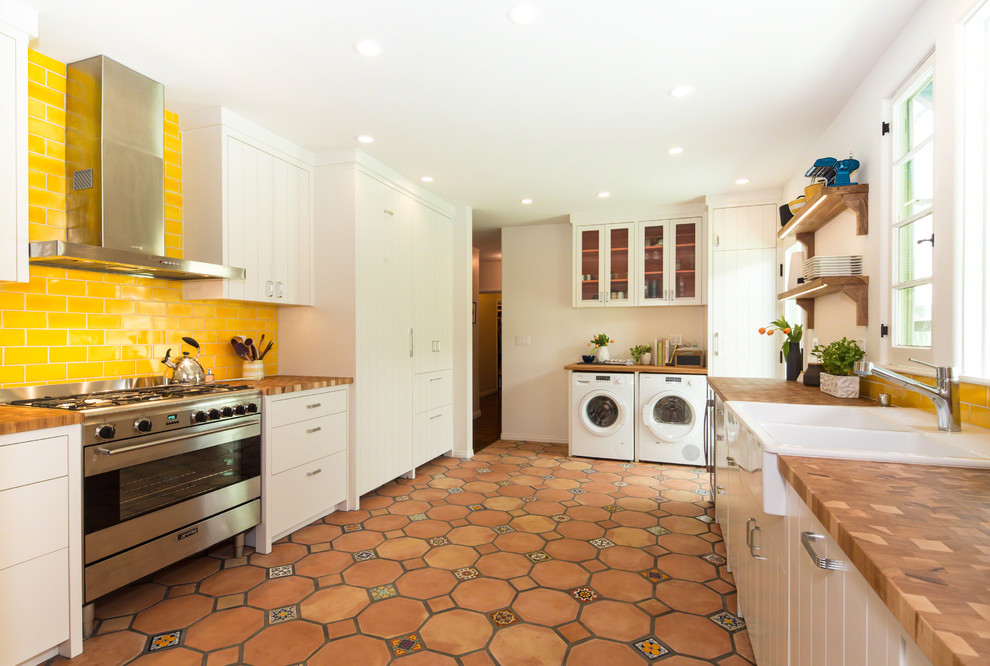
A lot of exclusivity will be obtained in the interior if you learn how to correctly use tiles in the “hog” style. Traditionally, there will be no problems with it, since it is universal, practical and, most importantly, original. You can add a lot of decorations to your interior with these tiles and create a truly attractive picture.
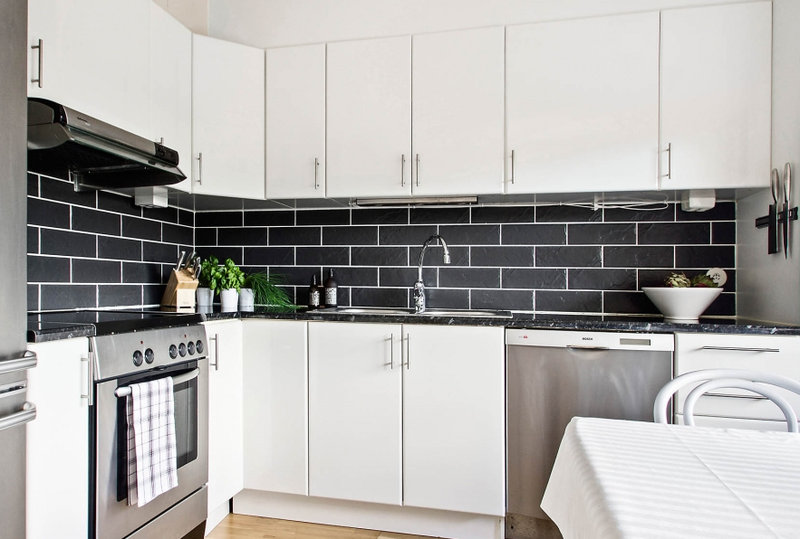
Hog tiles in different styles
Let's look at traditional styles that use boar tiles on the kitchen backsplash.
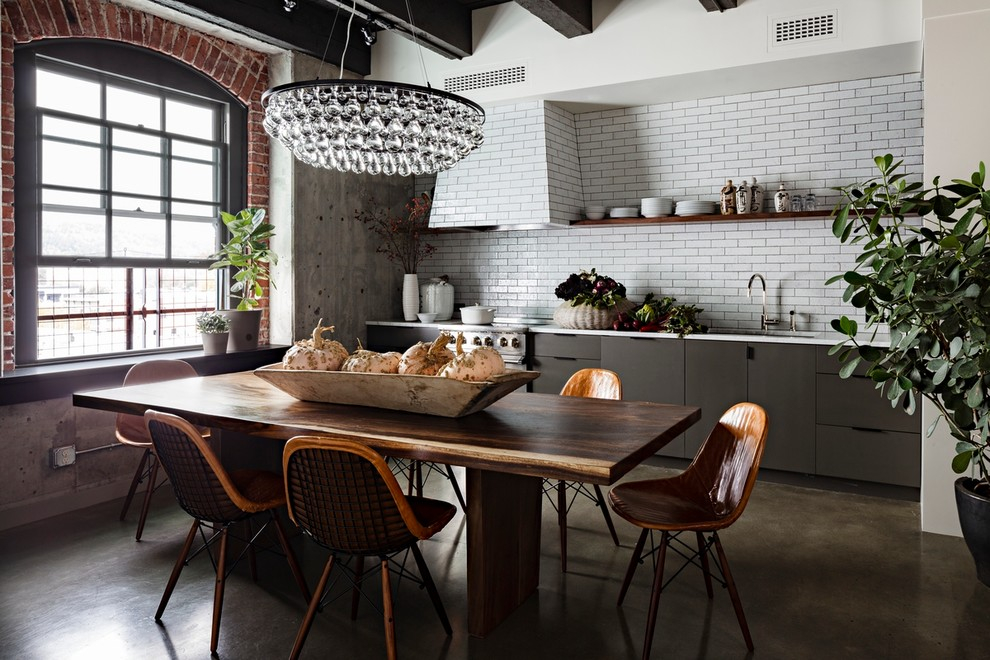
Art Deco
This style is very popular for conservatives and innovators, so its versatility dictates its application different forms and types of tiles. Fits perfectly into the interior White color tiles with the addition of exquisite mosaics, and also come in a large size that fits in a checkerboard pattern. In this style, you can combine several features at once - decorative features and conservative restraint, laconic details and monumental elements. By choosing a style, you will create maximum comfort in the room and be able to enjoy a unique atmosphere.
Scandinavian style
It is he who personifies the compatibility of several factors, traditionally elements that are rough and smooth at the same time. For example, may be perfectly compatible with brickwork. The name of the direction arose because of the Scandinavians’ love for it. Indeed, in many places in the kitchen and other rooms it was difficult to make masonry, so the “hog” began to be actively introduced and used.
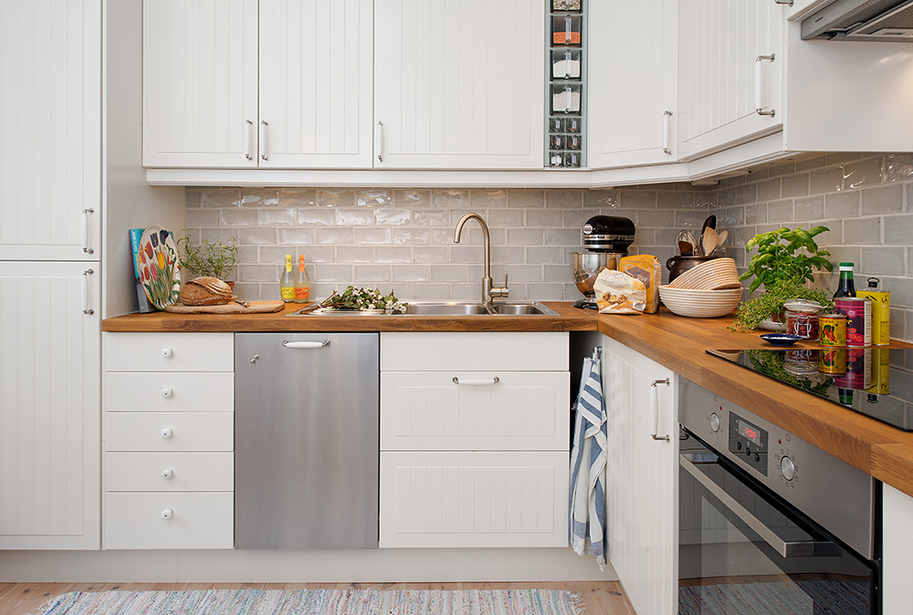
Industrial style and loft
It has several strong weaves with a past direction and includes a ton of features. IN loft style Numerous glass and wood elements may be present. Basically, the interior is similar to a restaurant kitchen or an entire food production workshop. On the walls of a room in this style, owners prefer to place large watch, similar to street units, and other metal elements may also be present.
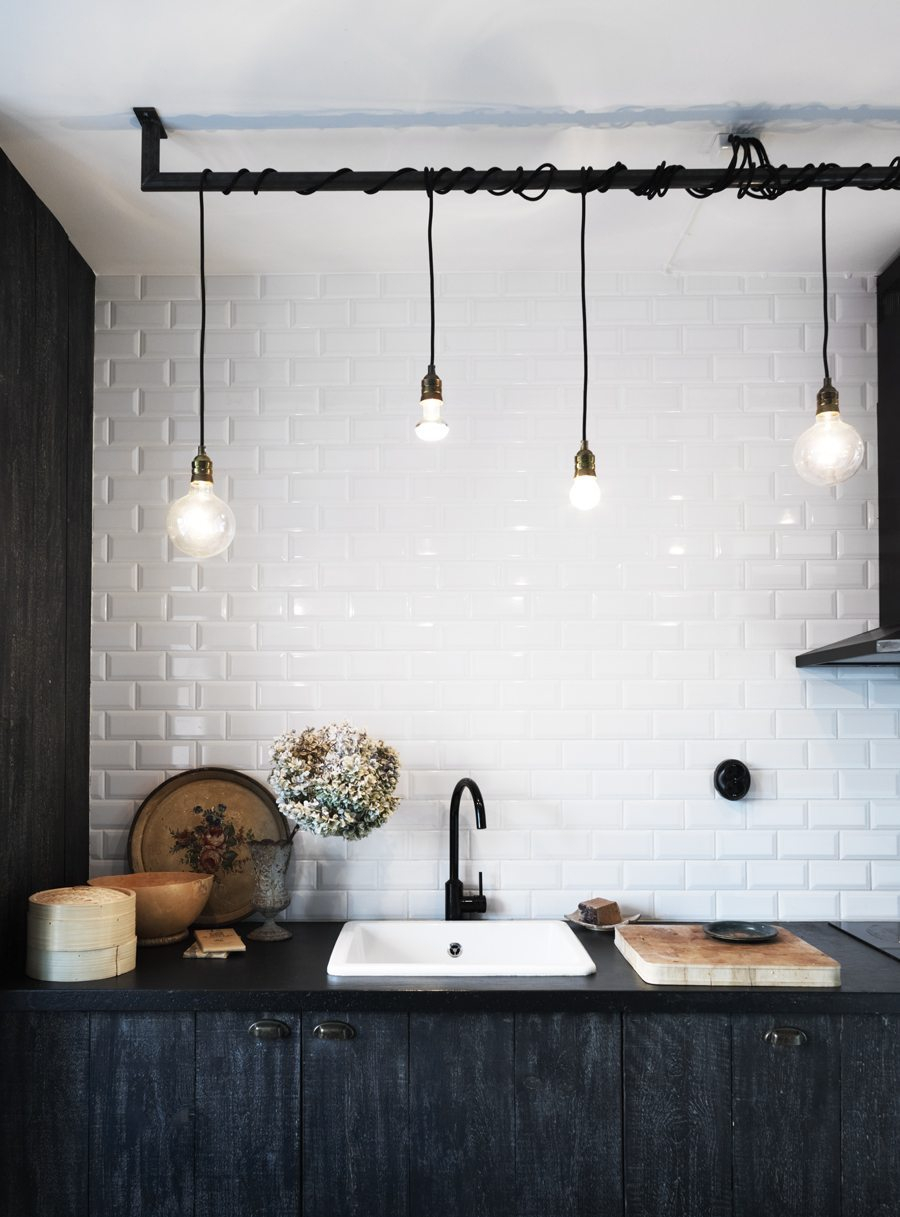
Classic style
Kitchen set In this style direction, it is traditionally equipped with wooden facades with a calm color orientation. In the style you can find ones that are located especially high, as well as retro-style faucets and other decorative elements. Observed integration of household appliances in pieces of furniture. Classics are usually simple in execution, but no one has canceled a competent approach to the design of stylistic unity, so be especially painstaking in the design of details.
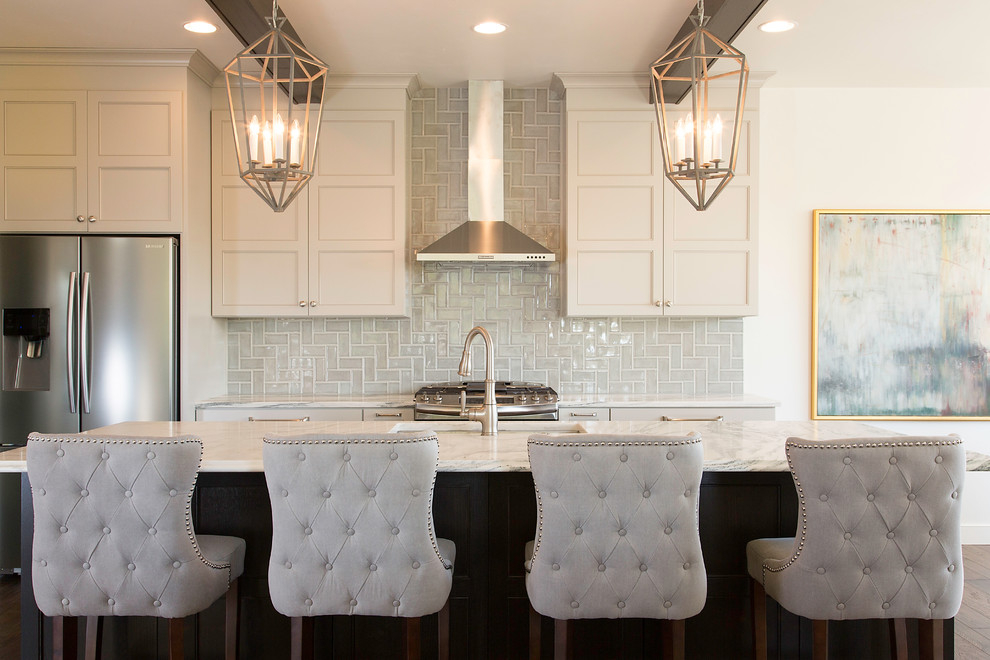
Strict classic style kitchens with hog tiles on the work wall
Country
Characterized by light colors and open cabinets, there is also a large number of shelves with dishes. Due to the brick effect, the “boar” can also complete the rustic appearance of the room and become its “highlight”.
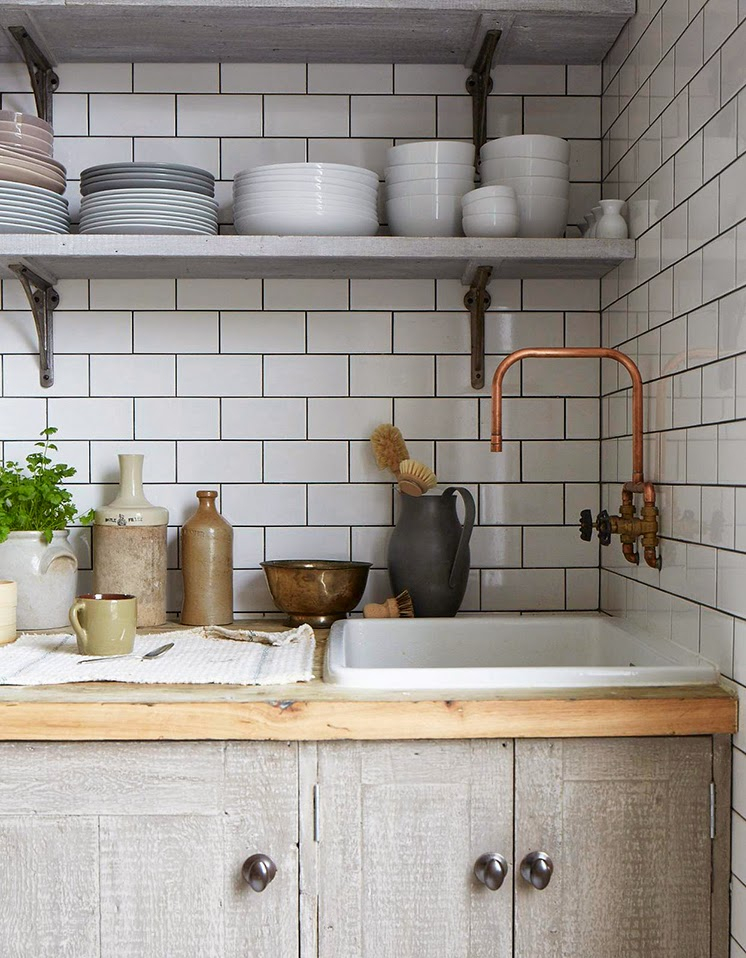
It turns out that the places that are most exposed to pollution and are the most vulnerable are covered with a special tile composition. The “boar” tile for the kitchen backsplash, the price of which is quite attractive, allows you to achieve the desired result in terms of interior design and create an original and luxurious image. In any style, this element will look original and appropriate, if, of course, it is applied correctly and efficiently.
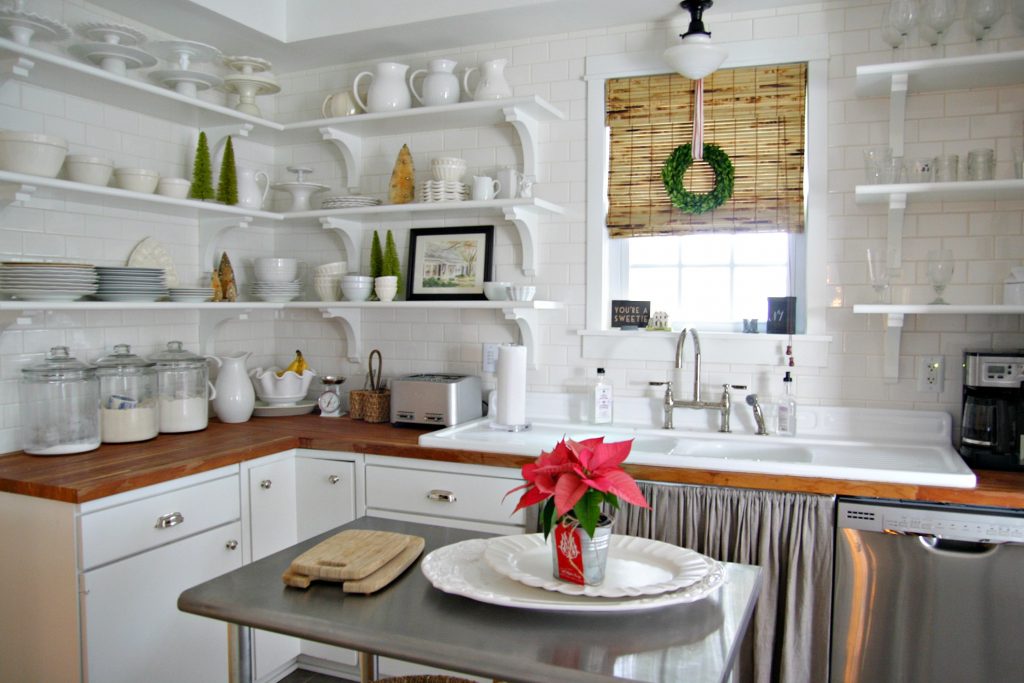
Laying features
The installation process will be easy if a proper and high-quality approach is provided.
- It all starts with preparatory work - the walls go through the processes of cleaning from old finishing coatings and applying a primer. Alignment with plaster- great move.
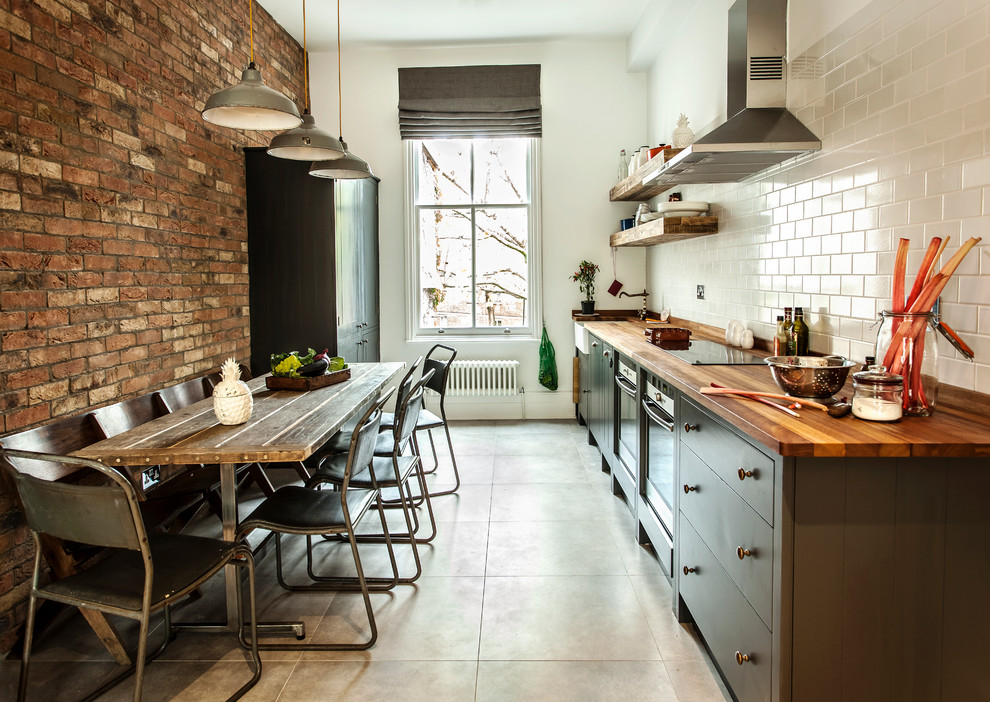
Interesting design solution finishing one wall with brick and the opposite wall with “hog” tiles - similar to brickwork
- After the plaster composition has dried, it will be necessary to apply another layer of primer. For this, specialized tools are used.
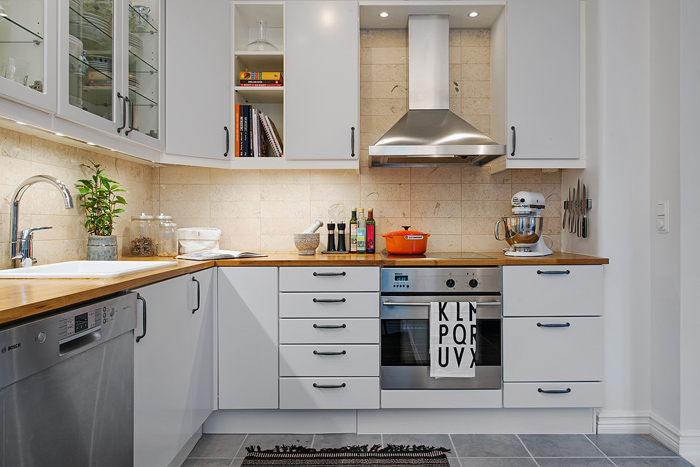
Practical and pleasing to the eye apron made of ceramic tiles “hog”
- The kitchen apron is an area of high humidity, therefore, the wall that is being treated must be covered with an antiseptic solution designed to protect it from external influences.
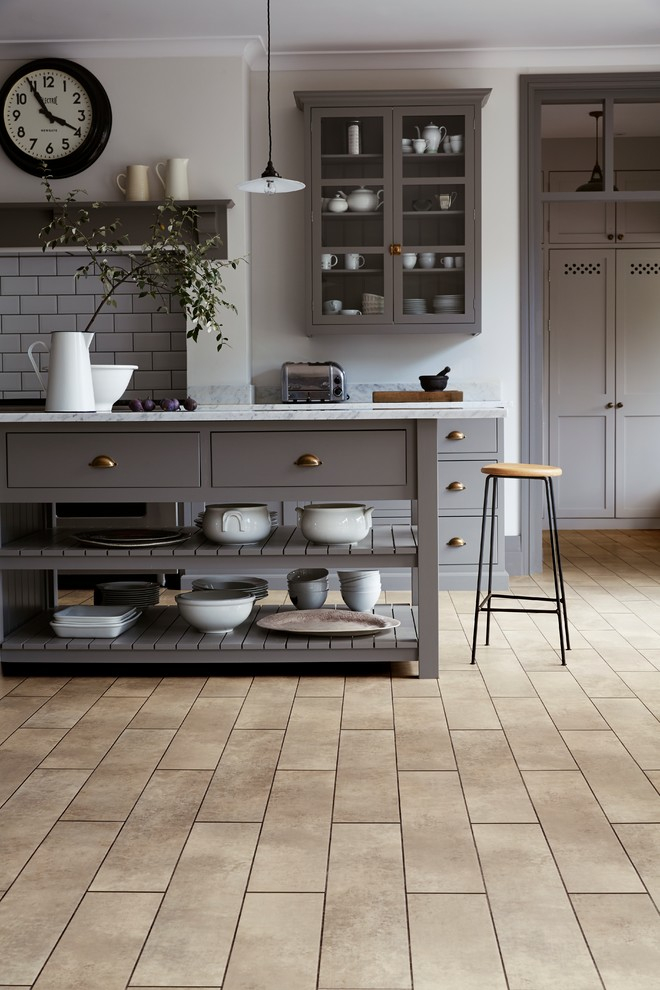
- It is important to wait until the surface is completely dry before starting all work. In particular, the process of laying the “hog” can be considered begun.
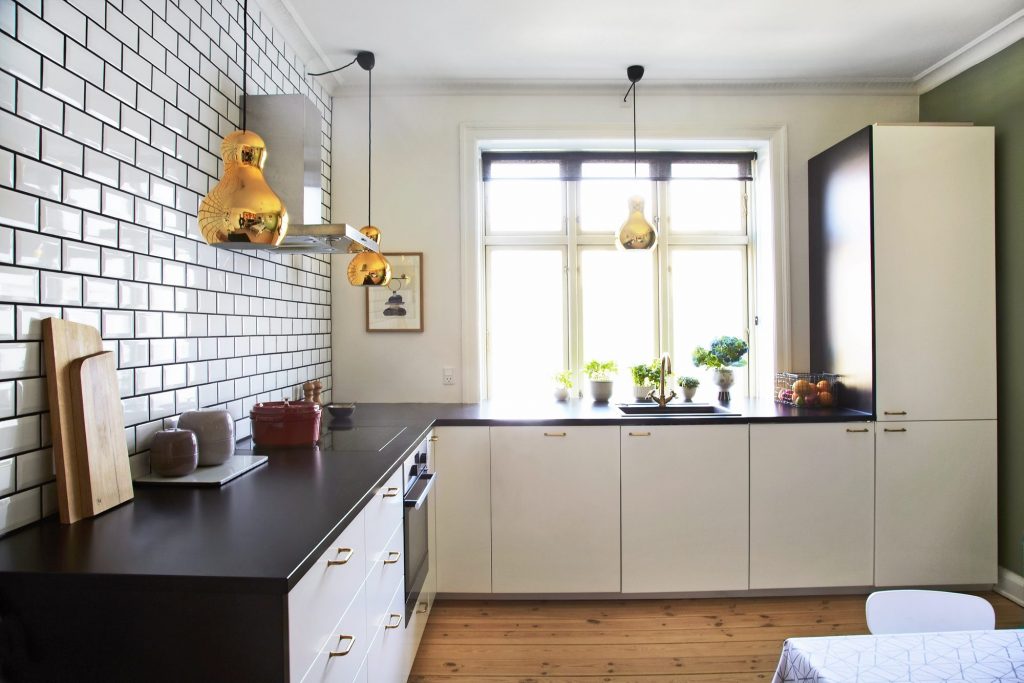
The “hog” tile in the kitchen interior looks much more interesting than ordinary classic ceramic tiles
- In order to ensure complete fastening of products, an adhesive composition based on a cement substance is used. The tiles are heavy, so adhesion will be ensured if the adhesive is applied twice to the wall and to the surface of the material.
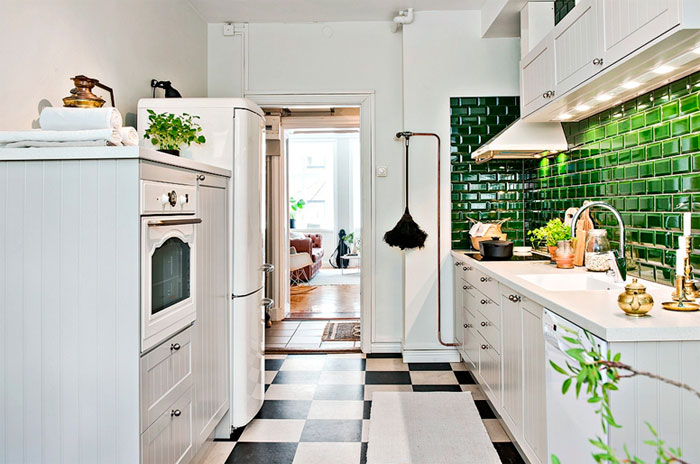
“Boar” tiles with a 3D effect will help smooth out uneven walls. A wide range of “hog” tiles will allow you to decorate any interior
Traditional “hog” tiles with a chamfer, in other words, convex
- To ensure that the seams between the tiles are not crooked and maintain identical dimensional parameters, it is necessary to use construction crosses made of plastic.
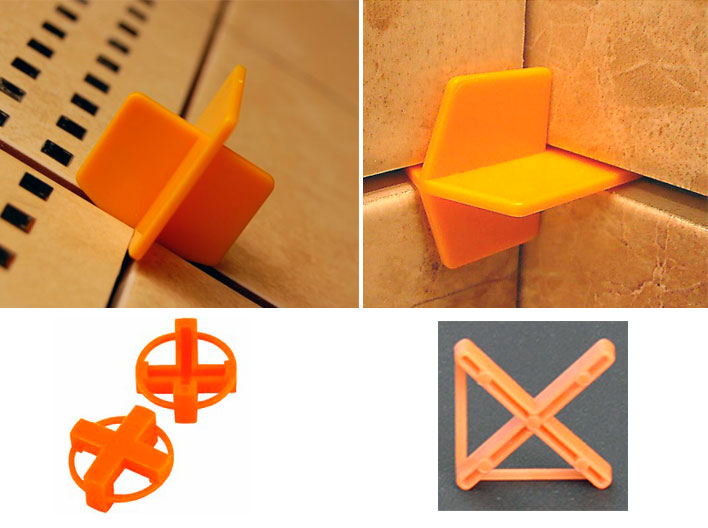
- The ideal option is to use, or rather create, a minimum number of seams, since it will be extremely difficult to clean this area of dirt, especially grease. To do this, it is most advisable to give preference to large-sized tile material, which may go against the design, since the most often used product is 10*20 cm.
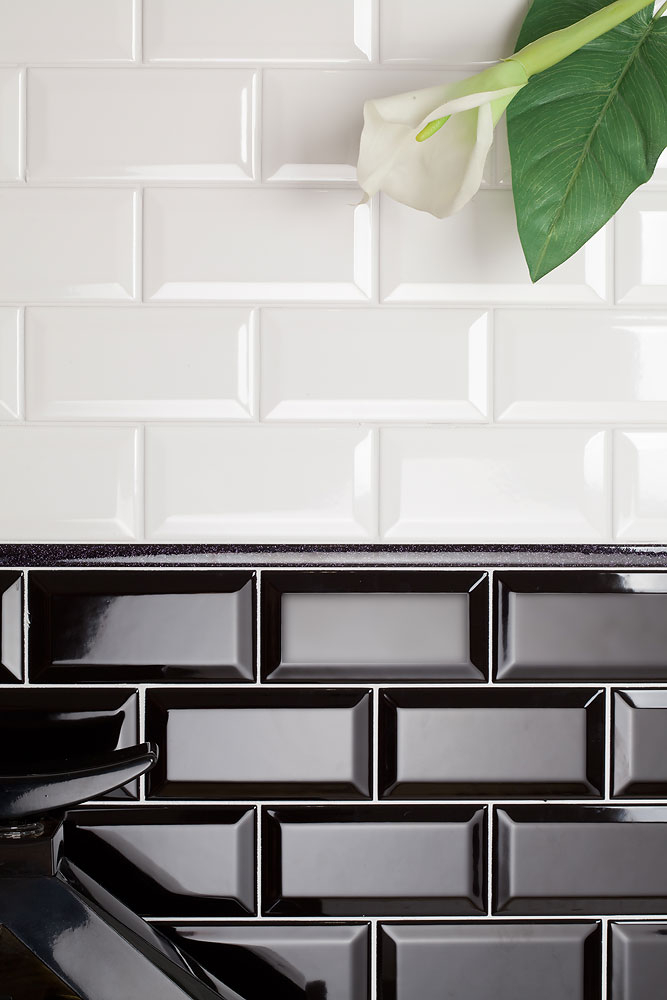
- After the installation process is considered complete, high-quality treatment of the joints is carried out using a grout mixture. The shade of this composition should be chosen so that there are no differences with the main tone of the tile, or that they are insignificant. Dark patterned tiles in a brick kitchen
- Restoration of seams. This type of restoration is carried out if the seams have lost their appearance due to the presence of mold, dirt or due to destruction.
- Complete replacement of damaged tiles.
- If there are cracks and chips, you can restore the damaged tiled surface using various materials– solutions based on cement, alabaster, using ceramic wax, etc.
- Use a construction knife with a diamond tip to remove the old grout.
- The grouted seams are washed from dirt, dried and filled with antifungal grout of the appropriate tone.
- Residues of new grout are removed with an aqueous solution.
- “Cement” milk (a solution containing cement in a minimum concentration). This composition should be rubbed into the crack, level the surface, allow to dry and paint over.
- A thicker cement solution is applied to the chip, leveled and painted over after drying.
- The crack can be masked with alabaster and then painted over with a coloring compound of the desired tone.
- Decorate a plain tile with a pattern using a stencil. In this case, water-dispersed latex or acrylic paint is used to apply the design.
- Decorate the tiles with stickers (the base is vinyl or silicone self-adhesive film). This is one of the most simple ways updating the appearance of the tile canvas.
- Completely repaint the tile canvas, radically changing the color scheme of the room. For this purpose, it is advisable to use acrylic paint compositions suitable for application to ceramic surfaces.
- Polymer panels;
- Washable wallpaper, including fiberglass wallpaper and liquid wallpaper;
- Moisture-resistant MDF panels, etc.;
White and colored tiles The “boar” on the kitchen apron is traditionally laid in a horizontal direction. There is a process of displacement, depending on the type of masonry. But in view rectangular shape and increased product flexibility there are other options installation work, for example, in the vertical direction, with a ladder, according to the herringbone principle, thanks to which even with the help of monochromatic designs you can create beautiful, simple designs.
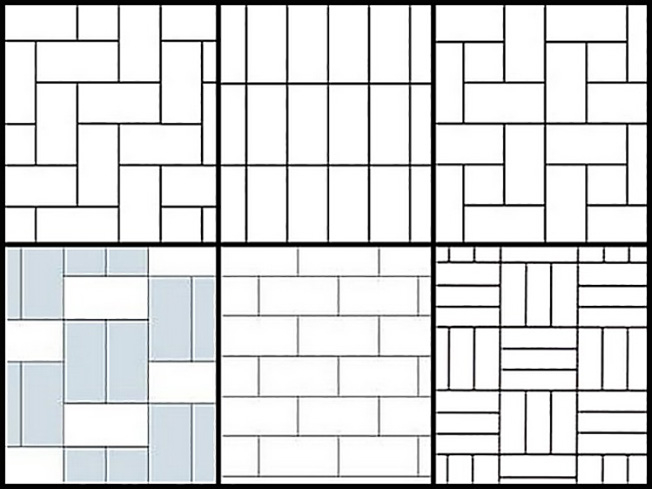
A type of patterned tile masonry “hog”
Ceramic tiles are one of the most practical finishing materials, the surface of which looks beautiful and is easy to sanitize. One of the undoubted advantages of tiles is its durability. However, during operation or during repairs, various damage to the tile cloth is possible. But tile restoration, carried out competently and carefully, allows you to return damaged tiles to their appropriate appearance, and also avoid a full-scale replacement of the tiles.
How to update tiles: basic methods
There are several options for restoring tiles, depending on the type and volume of damaged elements.
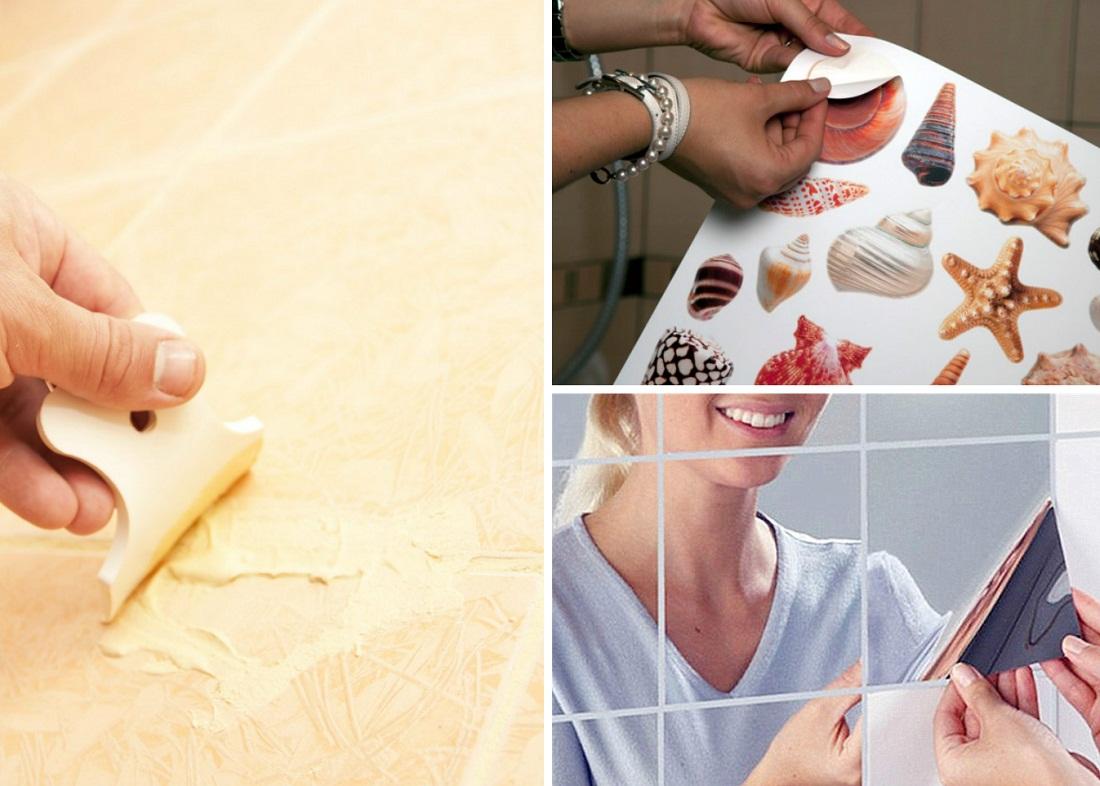
Namely:
It must be said that restoring tiles has a number of undoubted advantages, namely: it allows you to significantly reduce the amount of work and reduce the cost of repairs; minimizes the amount of cleaning, since there is no question of where to put the old tiles; allows you to leave your favorite tiles on the walls or floor, which you didn’t dare replace with another finishing option. Tile restoration should be resorted to when the tile has minor damage and the amount of work is small.
Instructions: how to update old tiles in the kitchen with your own hands
If the tiles in the kitchen have no mechanical damage, and only the seams spoil the aesthetic appearance of the tiles, then the grout can be replaced.
The progress of work is as follows:
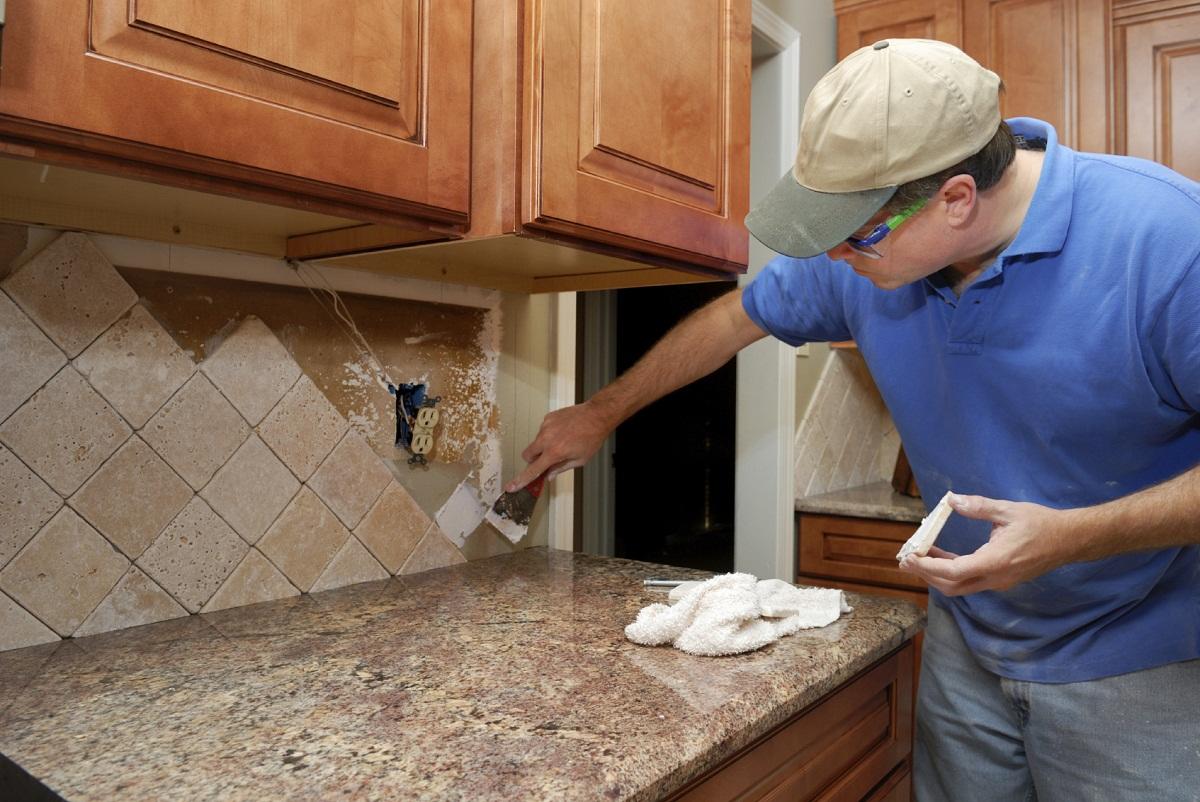
But to eliminate chips, one of the following is suitable modern methods restoration of tiles using innovative technologies– restoration with ceramic wax. So, restoration of chips is carried out in this way. The surface of the tile is cleaned, degreased and allowed to dry completely. Then you should fill the gas melter with gas, turn it on and set the desired temperature.
The melter separates small portions of ceramic wax of the appropriate color, and this material fills the chipped tile.
In this case, the wax must be applied with a slight excess, since after drying it shrinks. After using a melter with the same shade, it must be cleaned. Half a minute after application, excess wax is removed with the side of the wax spatula, which has a ribbed surface. The edge of the restored area of tile is sanded with the round side of a putty knife and then, if necessary, with sanding paper.
The restored area is fixed with a varnishing felt-tip pen to protect the tiles from dirt and dust. The area is covered with a thin layer of varnish. The gloss level of the area is adjusted using a sanding pad. If the tile is glossy, then you can additionally apply a layer of transparent wax to the restored area, and then fix the area with a varnishing felt-tip pen brush with the “High Gloss” icon.
In addition to ceramic wax, other materials can also be used to repair chips and cracks.:
There are many auxiliary compositions for the complete and accurate restoration of ceramic tiles - from the simplest to complex multi-component ones.
What can be glued to tiles: simple decor ideas
To update appearance ceramic tiles, you can use several simple solutions, which, among other things, allow you to close some surface defects.
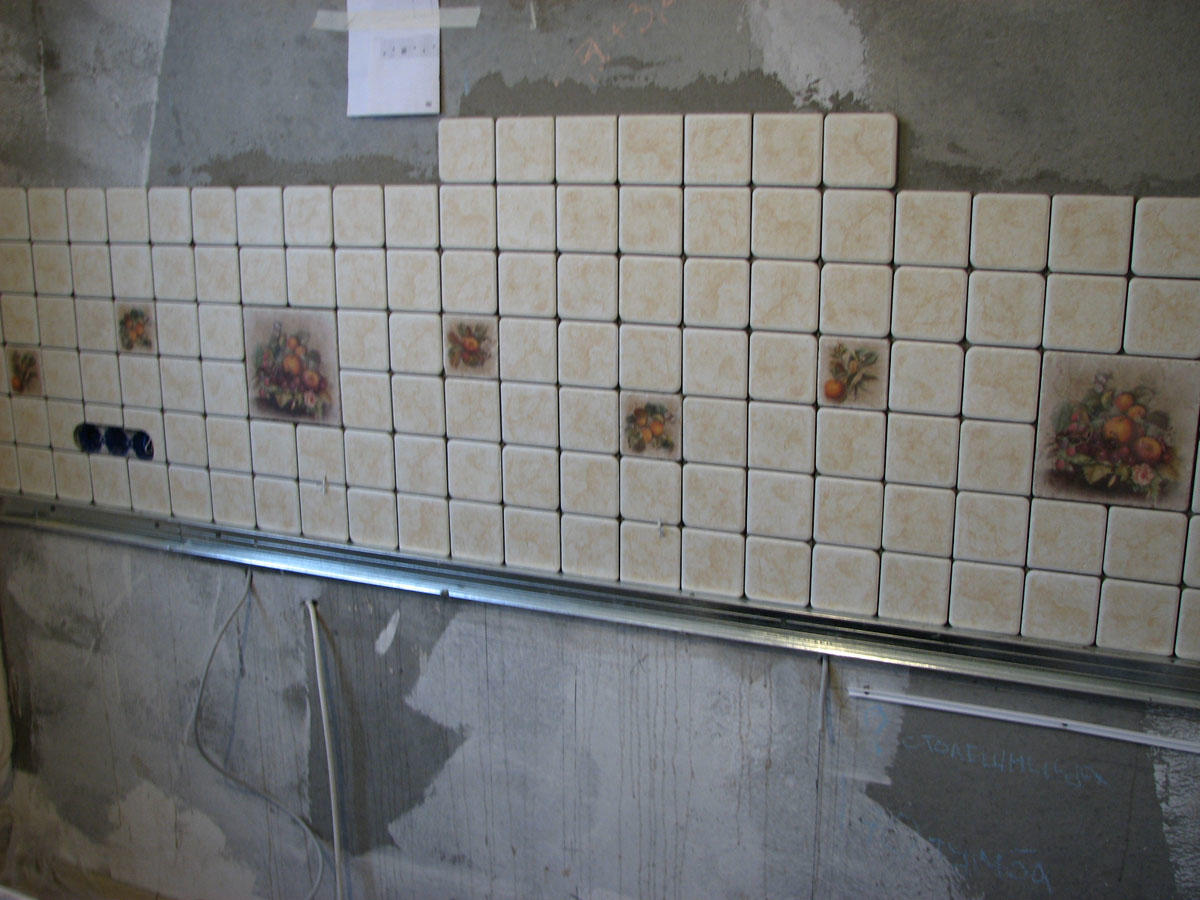
Namely:
You can restore ceramic tiles quickly and in an original way using graphic images; self-adhesive film, drawings, etc. are also suitable. This kind of decor is simple to implement and looks unconventional.
Alternative materials: how to replace tiles in the kitchen
Tile is one of the universal finishing materials, which is traditionally used for covering the surface of floors and walls in rooms with high levels of humidity - kitchen, bathroom, toilet.
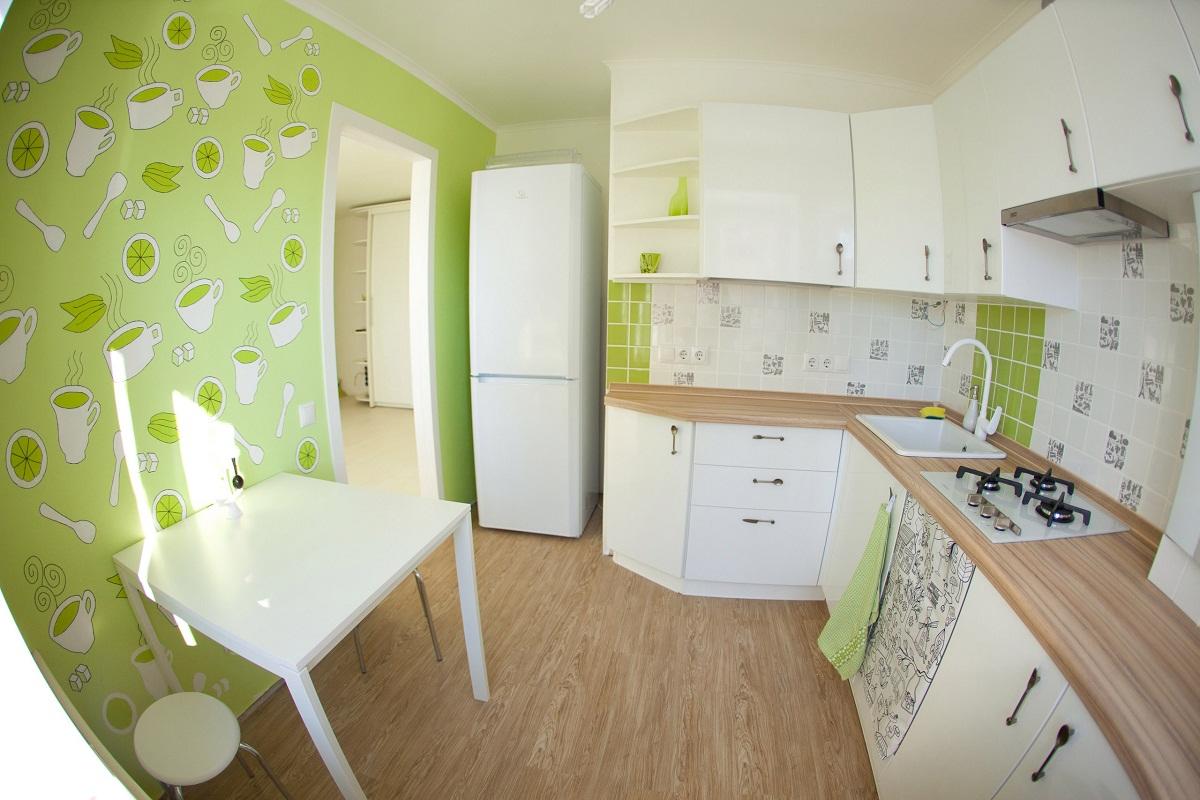
Of course, the process of laying tiles is labor-intensive, therefore, sometimes it is advisable to replace the tiles in the kitchen with such alternative finishing materials as:
It should be noted that all of the above finishing materials are significantly inferior in their strength properties, fire resistance and durability ceramic tiles. Alternatively, it is the kitchen working area, which experiences the greatest load and whose finish wears out the fastest, that, instead of tiles, can be decorated with tempered glass with various images, patterns, etc. There is also an expensive alternative to ordinary ceramics - tiles made from natural stone (marble, granite, etc.).
Tile restoration process (video)
Attention, TODAY only!



